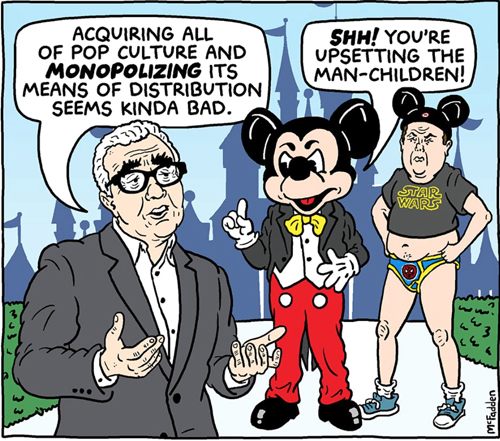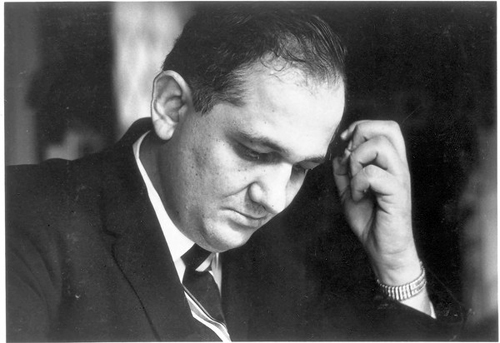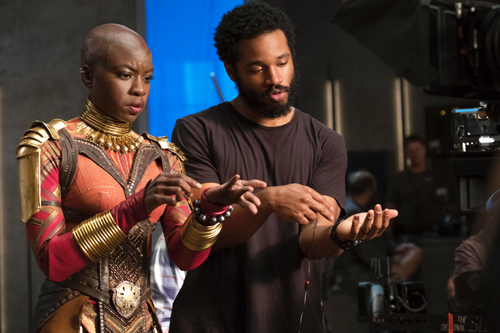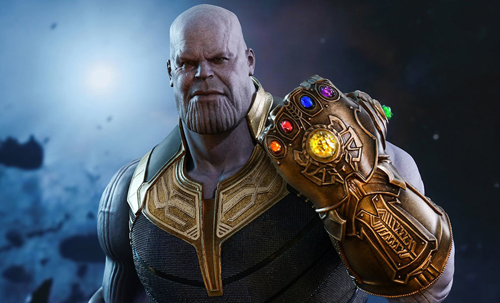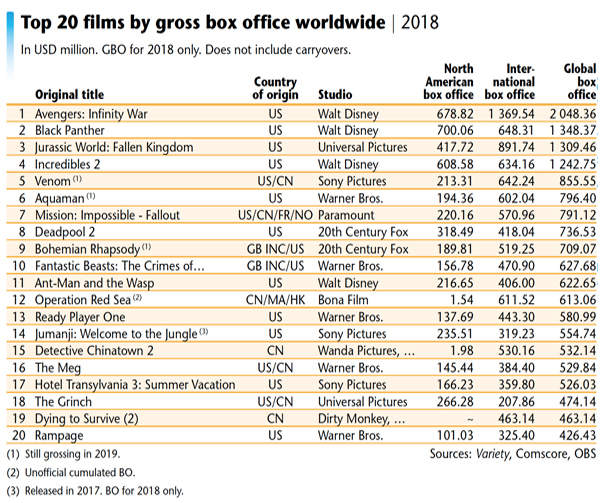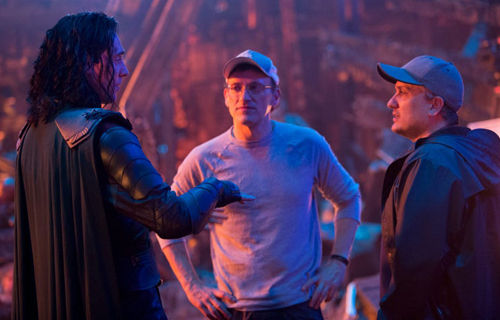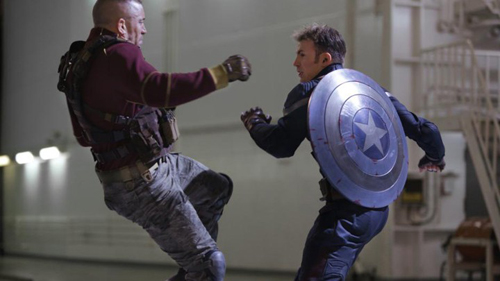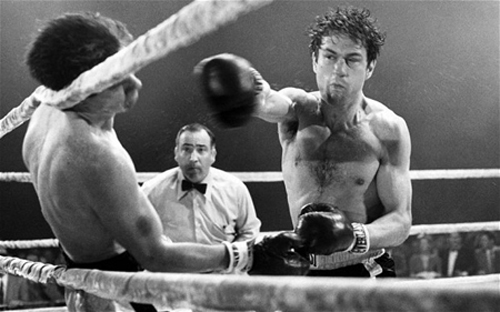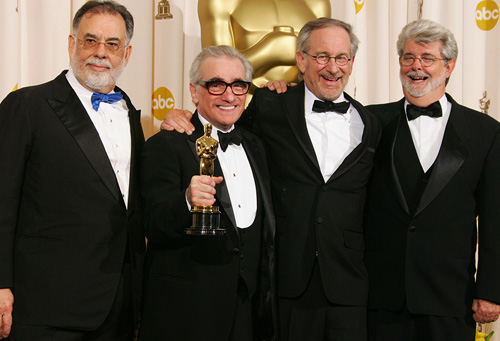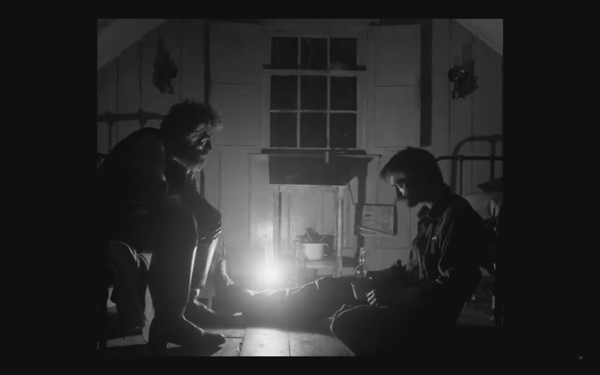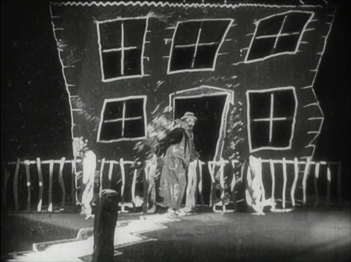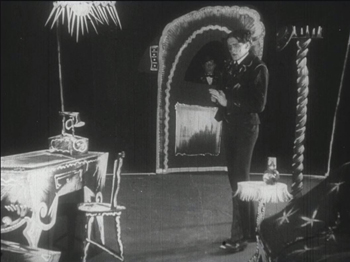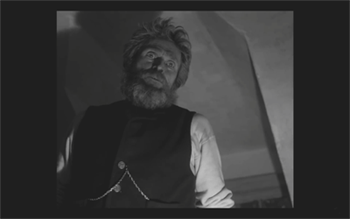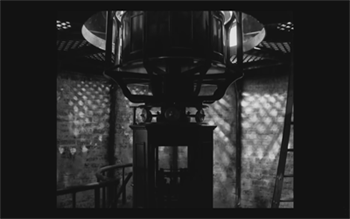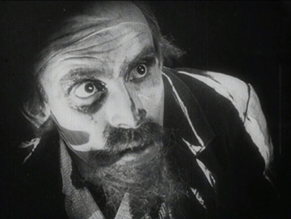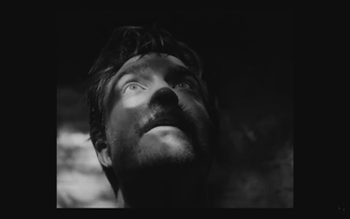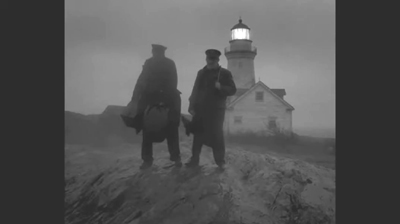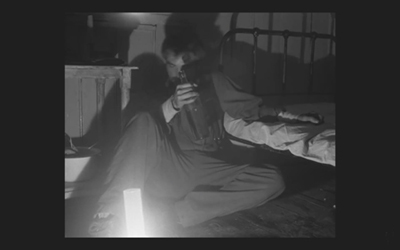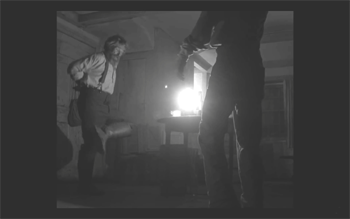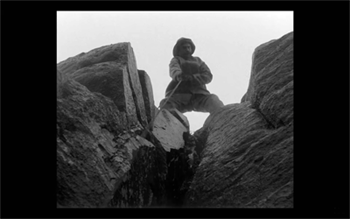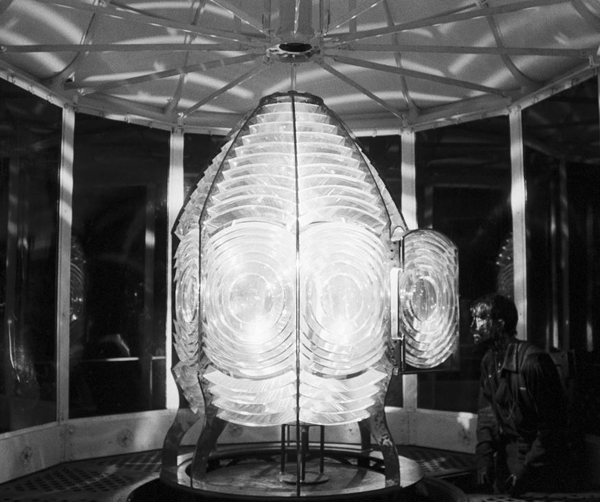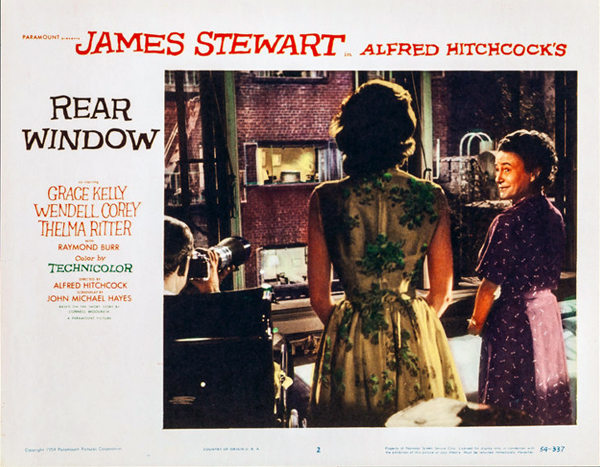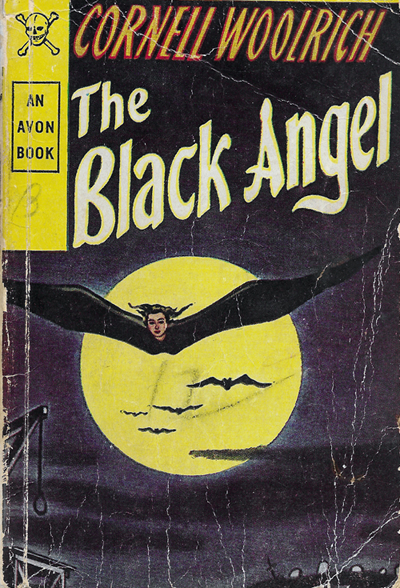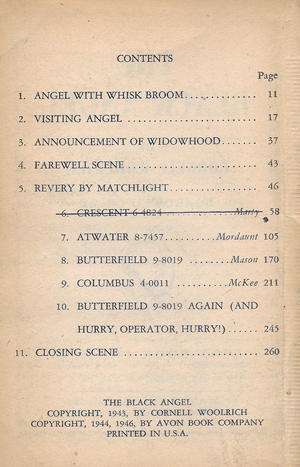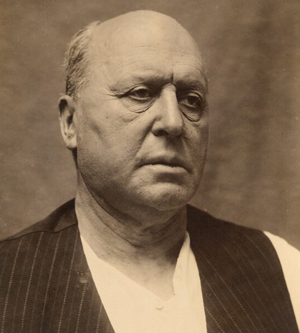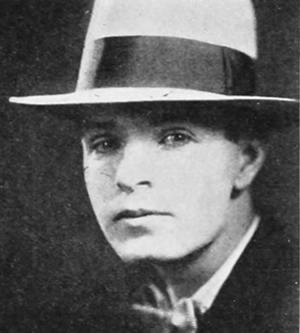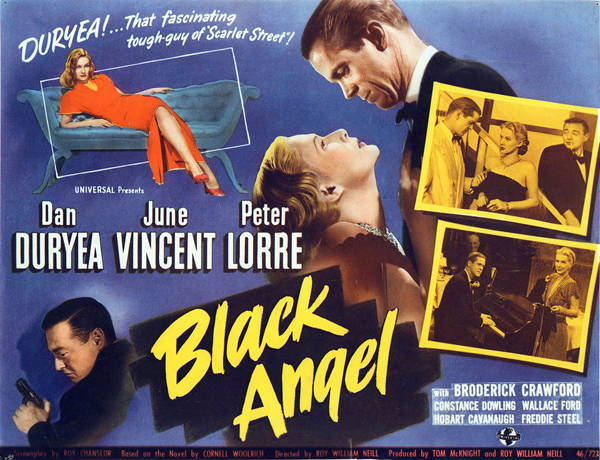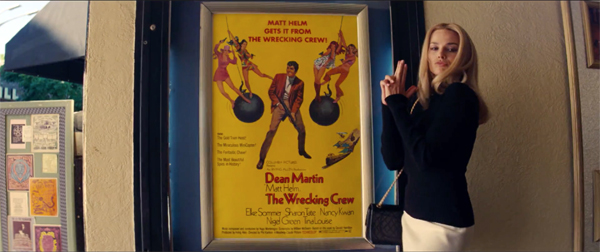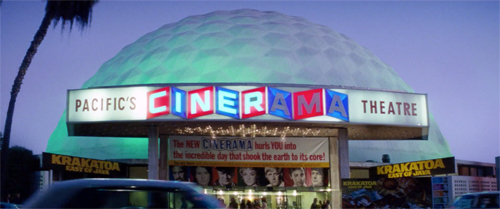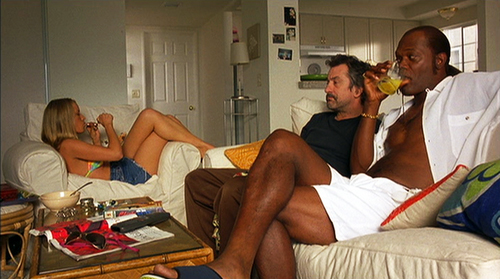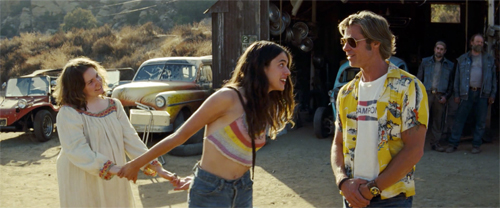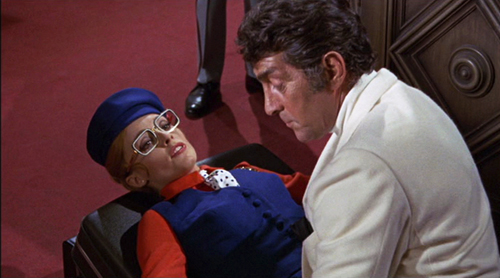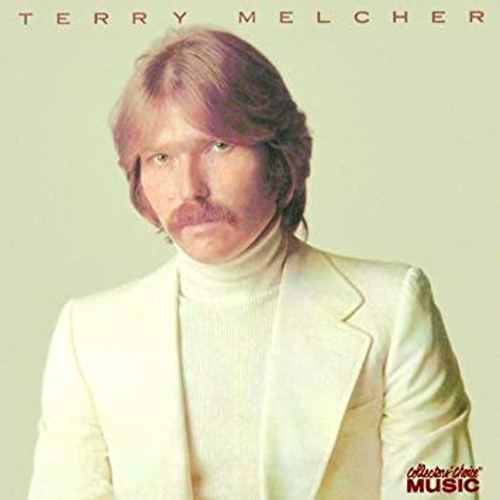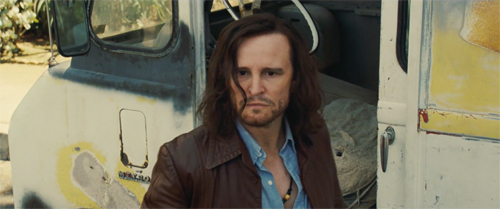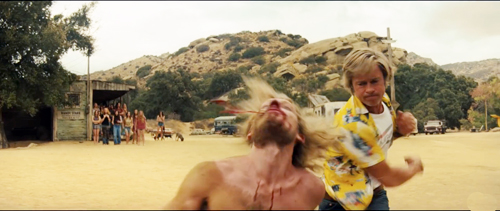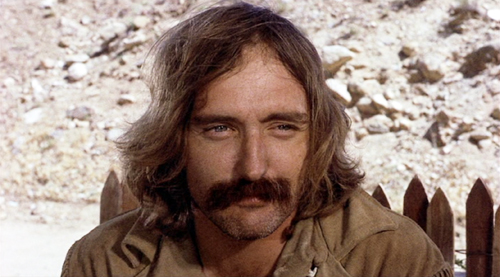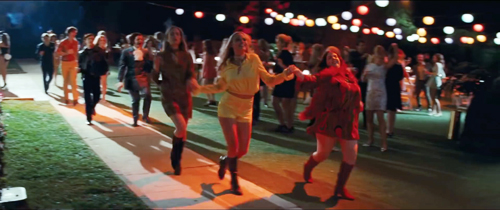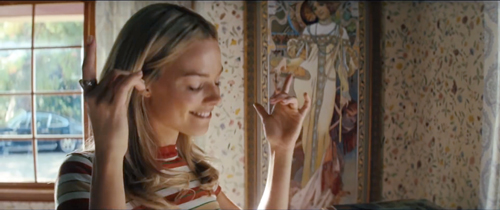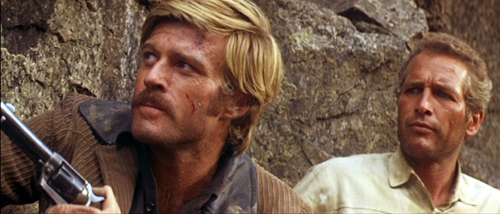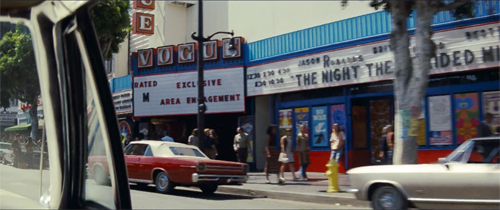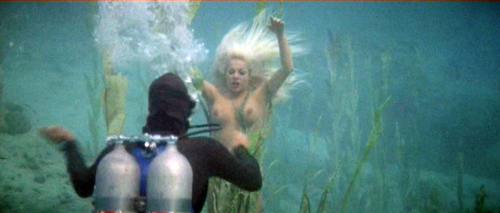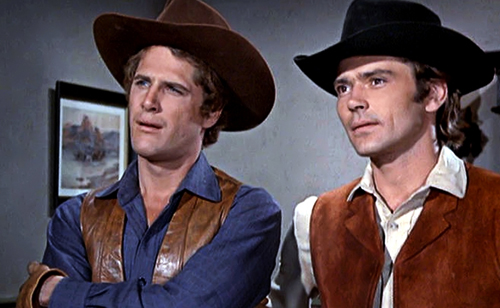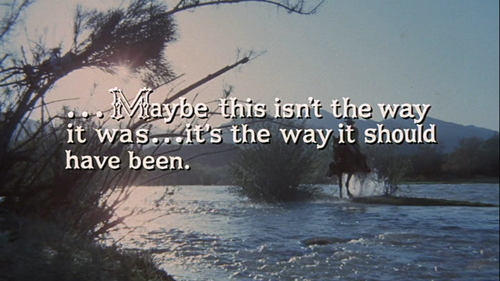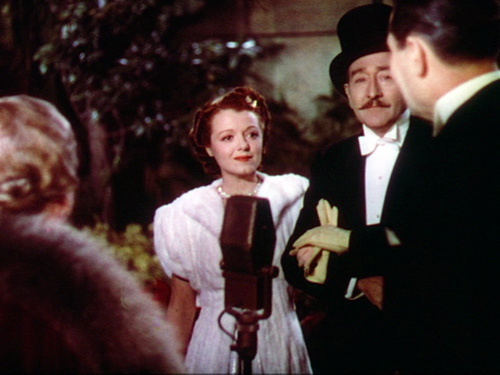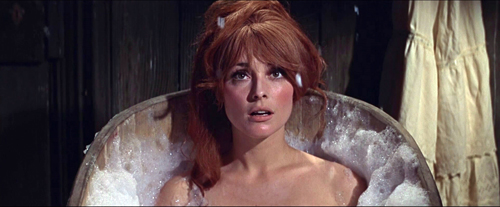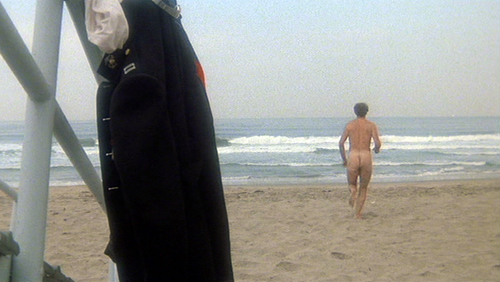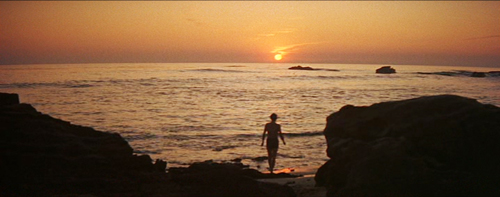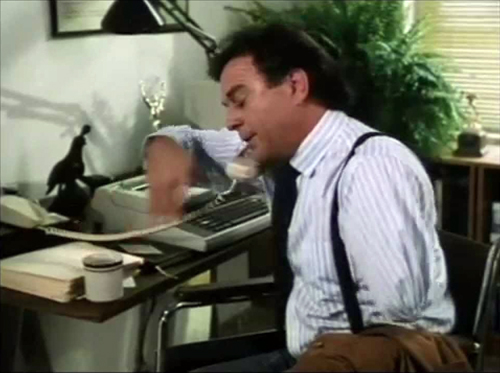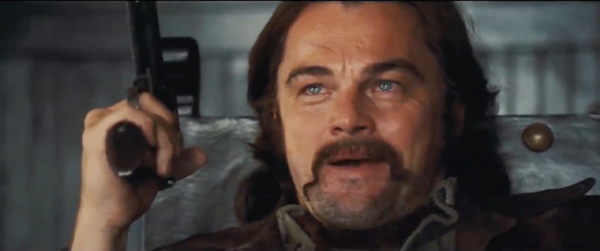Archive for the 'Film genres' Category
Captain Cinephilia: Scorsese strikes back
Brian McFadden, No One Is Safe: Martin Scorsese Roasts Your Fandom.”
DB here:
It started with a brief, almost offhand remark.
“I don’t see them,” [Scorsese] says of the MCU [Marvel Cinematic Universe]. “I tried, you know? But that’s not cinema. Honestly, the closest I can think of them, as well-made as they are, with actors doing the best they can under the circumstances, is theme parks. It isn’t the cinema of human beings trying to convey emotional, psychological experiences to another human being.”
When I learned about this interview (Empire, November issue), I took it as simply a roundabout statement of personal taste. Scorsese doesn’t find Marvel movies, and perhaps other comic-book sagas of superheroes, to his taste. He gave them a fair shot, but he now no longer sees them. He considers them visceral stimulation, like carnivals or theme parks. They’re not cinema, if you consider cinema as emotional expression of psychological conflicts.
In the massive responses to Scorsese, people pointed out that viewers often respond emotionally to superhero films. They root for certain characters, they’re amused or thrilled by certain situations, and many claim to be deeply moved by the heroes and villains (Loki, even Thanos). In fact, it’s exactly the “emotional, psychological experiences” embedded in the Marvel and DC plots that some fans say distinguish them from crude comic-book movies that went before. Much the same could be said of the Bond films, which became more humanized with Quantum of Solace, though intermittently before.
As for the claim that the superhero films “aren’t cinema,” I wasn’t really upset. Over the decades we’ve heard that 1910s films “aren’t cinema” (too theatrical), or that adaptations of novels or plays “aren’t cinema” (too literary or stagebound), or that narrative films “aren’t cinema” (usually proposed by avant-gardists). When the claim relies on a notion of some cinematic essence (editing, or pure visual form) that’s missing from this or that movie, you might be able to have a productive conversation. But if “This isn’t cinema” comes down to “I don’t like films like this,” we’re back to personal taste.
On other occasions Scorsese went on to say a lot more. The ultimate result was a 7 November article in the New York Times. I think we should take this as his most thoroughgoing effort to explain his thinking. We can supplement that with some remarks he made in interviews and Q & A sessions.
Herewith my attempts to figure out Scorsese’s argument. Trying to sort this out might teach us some important things about film now.
Scorsese in defense of Cinema
Scorsese’s Times article, “I Said Marvel Movies Aren’t Cinema. Let Me Explain,” begins by disclaiming any hatred for Marvel movies as such. “The fact that the films themselves don’t interest me is a matter of personal taste and temperament.”
But everyone’s taste gets shaped by their moviegoing experience, and in his youth Scorsese was attracted to films from America and Europe. These yielded “revelation—aesthetic, emotional, and spiritual revelation.” The films were, he felt, about characters who were complex, sometimes contradictory in their minds and behavior.
Moreover, these films showed that cinema was an art form, one existing in both commercial and more experimental spheres. Hollywood studio output (Ford Westerns, Hitchcock thrillers), European imports (Bergman, Godard), and avant-garde work (Scorpio Rising)—all these showed that cinema had powers equal to those of music, dance, and literature. These films were technically accomplished, sometimes virtuoso, but at their hearts were intense, complex emotional appeals that assured that they would be watched for decades later.
Today the Marvel pictures, often skillfully made, lack “revelation, mystery, or genuine emotional danger.” They are repetitive, adhering to a basic formula, “defined as variations on a finite number of themes.” By contrast, the films of Paul Thomas Anderson, Claire Denis, Wes Anderson, and other directors offer new and unpredictable experiences, and they expand the possibilities of the art form. “The unifying vision of an individual artist” is essential to cinema.
It’s exactly the exploratory filmmakers who are being stifled by the Marvel releases, and indeed all the franchises. These more personal films aren’t just constrained by lower budgets; they can’t get much exposure on theatre screens either. “Around the world, franchise films are now your primary choice if you want to see something on the big screen.” Most filmmakers design their films for that scale and that communal experience, but the blockbuster films are pushing smaller pictures into streaming outlets.
The franchise mentality is a corporate one. The products are “market-researched, audience-tested, vetted, modified, revetted and remodified until they’re ready for consumption.” As often happens, the business constrains the art. But you might say, what about the old studio system? Wasn’t that as mercenary as today’s franchise juggernaut? No, because the studios set up a creative tension between the business end and the artistic end that yielded outstanding works, even masterpieces. Today’s franchise producers are indifferent to art and hold a view of film history that is both “dismissive and proprietary.”
As a result we have two domains: worldwide audiovisual entertainment vs. cinema. They overlap less and less, and it seems likely that the financial power of one will dominate and belittle the other.
I think that some of these arguments are plausible, while others deserve more probing.
Film art: Who’s the artist?
Andrew Sarris.
During the 1950s and 1960s, this general argument was promulgated by the so-called auteur critics around Cahiers du cinéma and was developed and promoted by Andrew Sarris in the US and Movie magazine in the UK. Scorsese was deeply influenced by these ideas. He was one of many cinephile directors-in-training who assumed that the best films bore the “unifying vision of the individual artist,” who was the auteur (author) of the film.
What was considered the “auteur theory” is too complicated to explore fully here. Minimally, it’s the idea that, all other things being equal, in many movies (often the best ones) the director can be considered the source of the film’s distinctive artistic qualities. The director may achieve this by exercising near-total control (e.g., Chaplin), or working with close collaborators (Powell and Pressburger, Donen and Kelly) or serving as a “filter” for the offerings of various contributors (probably most filmmakers).
This is the minimal case. The maximal one rests on the idea that once we make the director the central power, we then discover a “unifying vision.” At this level the distinctive features of form, style, and theme coalesce into a personal conception of human life. For Ford, that might include the value of traditions and the costs they demand of those subscribing to them. Hitchcock’s recurring concern, Robin Wood famously argued, is the realization that complacency, a trust in social order, is vulnerable to disruption.
The difference between the two versions I’m sketching isn’t hard and fast. Still, it often holds good. A friend, for instance, grants that Tony Scott is a distinctive filmmaker. “He just has nothing to say.” The idea that an auteur has something consistent and personal to “say,” deliberately or unconsciously, from film to film, is a hallmark of auteur criticism at its most ambitious. And the greatest auteurs, perhaps, show development in what they say across their careers. John Ford’s attitude toward the frontier can be said to change from The Iron Horse (1924) to Cheyenne Autumn (1964).
The minimalist auteur concept isn’t new. From the 1920s on, historians and critics often attributed creative authority to Griffith, Chaplin, De Mille, Hitchcock, and European and Soviet directors. And in most film industries, executives recognized that the director had the most responsibility for the film’s look and feel.
One revolutionary edge of auteur criticism was to discover auteurs nobody had noticed before–largely unknown filmmakers working alongside humbler folk. And the critics went further, suggesting that some of these filmmakers could be considered auteurs to the max.
Typically auteur critics didn’t examine the concrete context of production to determine who did what in particular cases. They inferred directorial expression by watching lots of films and tracing recurring strategies of style and theme. Sometimes they backed their conclusions up by interviews with–who else?–the director.
Minimal versions of the auteur idea are central to film culture now. Festivals promote directors, as do studio marketers. Movie lists in reference books and search sites give directors the pride of place. Variety and Hollywood Reporter reviews usually don’t name producers, cinematographers, and other contributors, but the director is always mentioned (and blamed or praised for the film). Academics and cinephile critics ascribe more maximalist “personal visions” to directors around the world, from David Lynch and Spike Lee to Wes Anderson to Wong Kar-wai and Jane Campion.
Auteur +genre = ?
Black Panther: Danai Gurira (Okoye), Ryan Coogler on the set.
Despite the prominence of some directors, they’re usually not what draws audiences. In most countries, the mass-market cinema is dominated by genres that are populated by well-known stars.
Sarris and others assumed that auteurs built upon the foundations provided by genre conventions and star images. Ford gave the Western a new force not only through his images and use of music but also by redefining the star personas of John Wayne and Henry Fonda. Hitchcock and Lang worked with and against the conventions of the thriller, while Ophuls gave the melodrama a melancholic elegance. Or so goes auteur gospel.
The 1970s New Hollywood auteurs embraced genre filmmaking as well. Bogdanovich, Coppola, Altman, Woody Allen, and others tested themselves in a variety of genres. Even Scorsese tried a “woman’s picture” (Alice Doesn’t Live Here Anymore), a musical (New York, New York), and a biopic (Raging Bull). They are only roughly parallel to today’s indie filmmaker who, after a breakthrough project at Sundance or SxSW, signs on to make a franchise picture.
As a generous and enthusiastic cinephile, Scorsese has long subscribed to a version of auteurism. Perhaps one source of his misgivings about Marvel and its counterparts is that he can’t detect auteurs in these movies. Does that mean they aren’t there? Is today’s studio cinema largely a genre cinema, minus the classic bonus of high-end auteur expression?
One of his comments has attracted little notice. Scorsese remarks of the theme-park picture:
The technique is very well done but there is only one Spielberg, there is only one Lucas, James Cameron. It’s a different thing now.
This implies that even the franchise genres could sustain some degree of what Sarris called “directorial personality.” Admirers of Taika Waititi’s Thor: Ragnarock, James Gunn’s Guardians of the Galaxy, Ryan Coogler’s Black Panther, or Patty Jenkins’ Wonder Woman might agree. This has been one line of defense in the pushback to Scorsese’s comments.
Or maybe we should attribute whiffs of personal expression today to the producers (Bruckheimer, Kathleen Kennedy, Kevin Feige). Even in Hollywood’s heyday, we sense Gone with the Wind and Duel in the Sun as Selznick productions. Then there’s Walt Disney, surely a producer as auteur. I suspect that Scorsese finds these old films more inspiring than today’s behemoths.
Closing the drawbridge on Fort Multiplex
Avengers: Endgame (2019).
A genre can rise and fall in popularity. As the Western and the musical declined in the 1970s, horror and science-fiction gained traction as both programmers and A-list blockbusters. Add in the rise of fantasy, crystallized in the prestige accorded the Lord of the Rings installments. Oddly, as comic book sales declined, comic-book movies came to be a central contemporary genre. The superhero film proved a powerful blend of all these trends.
Today, the stifling presence of the fantasy/SF/comic-book franchises seems obvious. Look at two snapshots.
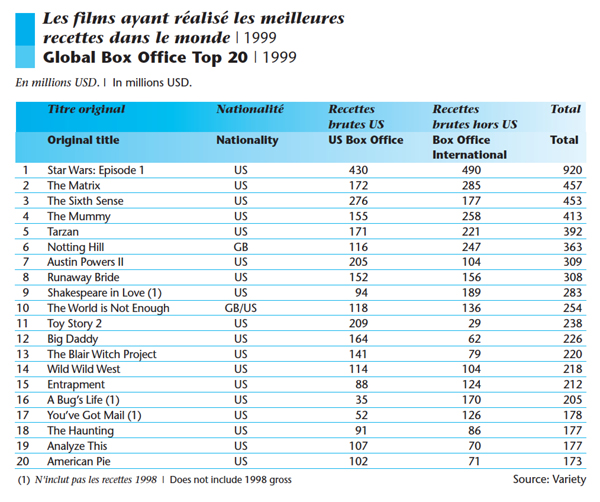
In 1999, the world’s top-grossing film was Star Wars: Episode 1. Among the twenty top hits were fantasy/SF blockbusters The Matrix and The Mummy, as well as a Bond entry. But there were also lower-budget horror films (The Sixth Sense, The Blair Witch Project). Most surprisingly, the top twenty include many comedies, mostly star-driven.
Now consider the 2018 situation.
Five of the global top ten were superhero films. The big winner was Avengers: Infinity War, which earned over two billion dollars globally–nearly twice as much as second-place Black Panther. Among the top ten are Venom, Aquaman, and Deadpool 2. Add The Incredibles as a sixth superhero film if you want. At 11 is Ant-Man and the Wasp. Most of the remaining titles are also franchise entries. There’s also the fantasy/SF blend Ready Player One, the monster movie Rampage, and the action thriller The Meg. Only China is offering live-action comedy (Detective Chinatown 2) and drama (Dying to Survive).
Of course nobody knows better than Scorsese that the big-budget fantasy/SF film has long been with us. His New York, New York (1977) came out the same year as Star Wars and Close Encounters of the Third Kind, while 1980 saw the release of both Raging Bull and The Empire Strikes Back. But in those years straight-up genre films had a fighting chance. Smokey and the Bandit, The Goodbye Girl, 9 to 5, Airplane!, and others won big box-office.
Scorsese films have landed in the top twenty occasionally (e.g., The Color of Money and The Wolf of Wall Street). On the whole, though, I’m not suggesting that Scorsese now sees himself as competing with the biggest grossers. He’s surely right that today’s superhero films dominate the landscape. But do they squeeze out other films to the degree he suggests?
In some venues, probably yes. Small towns with one or two multiplexes may not have space for the minor-key movie. But bigger towns and midsize cities can be quite hospitable to them. In one week, alongside the big releases, multiplexes in my town of Madison, Wisconsin (pop. about 250,000) played Motherless Brooklyn, Jojo Rabbit, Parasite, The Lighthouse, The Current War, Brittany Runs a Marathon, and documentaries on Molly Ivins and Miles Davis. At least some of these qualify as original vehicles. At its widest release, The Lighthouse played on nearly 1000 US screens, and Jojo Rabbit arrived at over 800.
These are merely data points, not systematic samplings. And you might argue that we’re in the middle of Oscar qualifying season, so more offbeat films are numerous now. Okay, go back to July, the most competitive month for domestic releases. Nationally, the big pictures didn’t prevent the release of Yesterday, Midsommar, Late Night, The Last Black Man in San Francisco, Booksmart, The Dead Don’t Die, The Biggest Little Farm, The Farewell, The Art of Self-Defense, Amazing Grace, and Once Upon a Time…in Hollywood.
Again, not all of these count as auteur vehicles, and several failed domestically, but they still squeezed into multiplexes. The Tarantino film obviously commanded a wide release, but many of the titles I mentioned played on between 1000 and 2000 screens. Booksmart opened on over 2500, Midsommar on 2700.
The industry doesn’t depend on the smaller or more personal titles, but then it seldom has. The biggest box-office successes in the heyday of the studio system were almost never auteur classics. Variety reported that the top domestic hits of 1943 were For Whom the Bell Tolls, Song of Bernadette, This Is the Army, Stage Door Canteen, Random Harvest, Hitler’s Children, Casablanca, Madame Curie, Star Spangled Rhythm, and Coney Island. True, Frank Borzage struck gold with Stage Door Canteen, but it’s not typical of his work. Lubitsch (Heaven Can Wait) and Hitchcock ( Shadow of a Doubt) were far down the list, bested by the likes of Sam Wood, Clarence Brown, and Henry King.
Or take 1952, ruled by The Greatest Show on Earth (De Mille), Quo Vadis, Ivanhoe, The Snows of Kilimanjaro, Sailor Beware, The African Queen (Huston), Jumping Jacks, High Noon (Zinneman), and Singin’ in the Rain (Donen/Kelly). True, The Quiet Man hit number 12, and Mann’s Bend in the River number 13. But of the top hundred the only other auteur pictures seem to be Pat and Mike (no. 39), Monkey Business (no, 47), Carrie (no. 54), The Lusty Men (no. 76), and Five Fingers (no. 85).
It seems plausible, then, that in Hollywood “audiovisual entertainment” has overwhelmingly dominated the market for decades. Auteurs seldom win the biggest grosses. But again Scorsese’s career history may have influenced his judgment.
There was a moment, the Holy 1970s, when genre cinema with a personal-vision inflection was occasionally lucrative. The Godfather, One Flew over the Cuckoo’s Nest, American Graffiti, Blazing Saddles, Alien, Apocalypse Now, The Shining, and other notably original productions did earn money and awards. Yet in retrospect that seems an interregnum. The top rentals of the following decade, the 1980s, were dominated by Spielberg and Zemeckis. Then there were the usual array of star-driven comedies and action pictures. Genres came back strong, and auteurs had to work within them, or around the edges.
Such is pretty much the case right now. At the top end, perhaps the superhero films are roughly equivalent to the biblical sagas, historical pageants, and theatrical adaptations that roadshowed throughout the 1950s and 1960s. Now as then, a number of auteur films are still getting theatrical releases. The blockbusters keep the lights on and the popcorn moving so that theatres can afford to wedge straight-up genre pictures and offbeat indies into their week. It seems that you can’t run Avengers: Endgame on all 22 screens.
Art vs. craft?
Anthony and Joe Russo directing Avengers: Endgame.
But maybe we shouldn’t think of the big pictures as “audiovisual entertainment.” What’s opposed to that? “Cinema,” Scorsese said. I’d propose that this formulation means “artistic cinema.” Which is to say that we’re in the realm of the classic distinction between art and entertainment.
This has given an opening to the people riled up by Scorsese’s remarks. Admirers of Marvel, DC, and comparable pictures can say that they find them as emotional, revelatory, inspiring, etc. as anything he finds in Bergman or Sam Fuller. They feel it in their bones. And who’s to gainsay that? Scorsese doesn’t have their bones, and neither do you or I.
On more objective grounds, I suggest that Scorsese has floated another distinction. Forget calling some things “cinema” and some things not. I think that he’s distinguishing craft from art.
Let’s say provisionally that craft is the skillful manipulation of the medium to produce the desired effects. Art, on this understanding, can be considered something more. It’s usually grounded in craft, but not always. It’s also formally and emotionally complex, original in its relation to what came before, and offering new experiences on repeated exposure (rather than replays of the original response). Many, like Kareem Abdul-Jabbar, would add that art induces reflection on ourselves and the world, making us wiser and deepening our humanity.
From this angle, Scorsese’s recognition of the “talent and artistry” of franchise films can be seen as a nod to craft competence. “The technique,” he says, “is very well done.” Our blockbusters are comparable to many of those anonymous hits of the studio era, turned out by skillful but impersonal artisans.
In response, the MCU advocates would need to show that the films go beyond craft. For example, some advocates find in these films the kind of character complexity Scorsese attributes to Hitchcock. He finds that Roger Thornhill in North by Northwest suffers “painful emotions” and an “absolute lostness.” Marvel fans will say something like this about moments in the stories of Tony Stark, Captain Marvel, Captain America, and the Winter Soldier.
Scorsese might reply that these are not complex characters. Yet for many years people said the same about the work of Hitchcock and other Hollywood auteurs. When people started to study them, we saw things differently. Only closer analysis of the comic-book films can give us better grounds to argue about whether their characters exhibit the “contradictory and sometimes paradoxical natures” Scorsese champions.
Realism and its rivals
Captain America: The Winter Soldier (2014); Raging Bull (1980).
A few scattered speculations and I’m done.
I don’t know that we’ve fully recognized that these SF and fantasy franchises descend from earlier forms. Silent crime serials and installment films featuring Dr. Gar el-Hama and Judex had the same reliance on secret identities and world-threatening master villains. Chinese wuxia films gave their knight-errants the power to soar into the air (the “weightless leap”) and emit blasts of energy (“palm power”). The bullet ballets of Hong Kong films have obviously influenced Hollywood action pictures, but we haven’t acknowledged how our comic-book movies incorporate fantasy martial arts techniques. Hollywood owes Asian action cinema more than we usually admit.
But the silent policiers and the fantasy wuxia are flagrantly unrealistic. And Scorsese, more than many of his colleagues, is committed to realism. He couldn’t, I think, make Big Trouble in Little China or Kill Bill. I’d suggest he’s intrinsically out of sympathy with quasi-supernatural action. (Hugo is a historical film, and it’s about a sacred era of Cinema past.) Superhero dramaturgy, I hazard, rubs him the wrong way, and not just because it lacks psychological depth.
I’ve argued elsewhere on this blog that Scorsese makes forays into expressionist and impressionist technique, but they usually issue from a base of harsh realism. His commitment to realism may make it hard for him to engage with the more outrageous narrative conventions of the superhero film.
Here another classic dichotomy suggests itself. If you have to choose between basing your story on plot or character, Scorsese will choose character. In fantasy films, though, character motive and reaction are based on elaborate plot machinations. These films depend a lot on elaborate fake identities, as well as recognitions of hidden kinship. She’s my sister! He’s my father! Such devices serve to provide intricate genealogies and networks of relationships for fan homework.
Likewise, theatrical melodrama and adventure fiction from the nineteenth century supply superhero sagas with orphans of mysterious parentage, duels, hairbreadth escapes, family secrets, coded documents, precious but mysterious objects, and other franchise conventions. These are woven into complex schemes and counter-schemes of the sort found in the silent crime serials. But all these features run counter to the psychological conflicts that animate Scorsese’s plots.
Recognitions of kinship rely in turn on a plot strategy that’s worth discussing a little more; I suspect it yields much of the emotional resonance that fans enjoy. These films rely on courtship and romantic rivalries throughout, of course, as well as friendships forged and broken. These are standard for most American genres. But I’ve been surprised at how often family relations are developed in complicated ways.
It’s not just Star Wars. The Marvel Universe relies heavily on kinship to sustain its plots, as well as its pathos. Tony Stark and Pepper Potts have a daughter, as does Scott Lang. Hawkeye has a family, as does T’Challa, whose cousin N’Jadaka becomes a prime adversary. Nebula and Gamora are pressured to be dutiful daughters to Thanos. Thor and Loki share a mother, Frigga. You can argue that Tony Stark becomes a father-figure for Peter Parker. Other characters are more isolated, but for some of them, notably Natasha and Bucky, the Avengers team constitutes a surrogate family.
Marvel’s focus on the family asks us to exercise the skills we must bring to classic mythology, nineteenth-century novels, and TV soap operas. We need to keep track of who’s related to whom, and what in their past encounters can arouse obligations and conflicts. I don’t think that plots resting on such dense kinship relations are of great appeal to Scorsese; his families, when they’re present at all, are pretty small-scale (Raging Bull, Cape Fear, Shutter Island, The Age of Innocence).
Most of all, when Scorsese speaks of these films shying away from risk, I suspect he’d include their avoidance of narrative risk. In fantasy and SF, nobody need really die. Hero, villain, love interest, and sidekick can return in a parallel world, or they can be resuscitated through a new gadget. The worst outcome need not be the worst, as when Avengers: Endgame uses nanotech and time travel to rewrite the past. Plot mechanics again. Despite all the assurances that Tony Stark is really, really gone, we could find a way to bring him back if Downey wanted to sign on again. (Black Widow is being resurrected for a prequel adventure.) But there’s no bringing back Sport from Taxi Driver or Rodrigues from Silence—except in a prequel, another convention that Scorsese would likely disdain.
I’m just spitballing here, but for Scorsese and other stylized realists like Michael Mann, the comic-book convention of eternal return might seem merely juvenile wish fulfillment. Something really has to be at stake, and ultimates must be faced’ Danger and death are real. This is grown-up drama.
I’m not intrinsically opposed to the conventions ruling comic-book movies myself. In general, I think that plot is as underrated as character is overrated. (I’d rather give up the distinction altogether, but that’s another story.) Superhero films are mostly not to my taste, but I think they’re worth studying as intriguing contributions to trends in modern cinema. My point is just that the personal aesthetic of Scorsese, as both cinephile and cineaste, doesn’t fit very well with the elaborate, ever-changing rules of the magical MCU. He finds enough magic in a sinuous tracking shot, or a carefully synced doo-wop song, or an unexpected angle, or a wiseguy shouting match. That is Cinema.
There are other questions we might ask about Scorsese’s remarks. For instance, when he celebrates the thrill of communal moviegoing as a central feature of Cinema, he seems to ignore the fact that the franchise pictures are our prime multiplex attractions. Many viewers slot the more “personal films” into a future Netflix queue, but they commit themselves to seeing the big films on the big screen. That choice can yield contemporary viewers some of the electricity that Scorsese found at a screening of Rear Window. And when they’re not checking their text messages or chatting loudly with their pals, they might even give themselves up to laughs, screams, and applause, just as in the old days.
Since I wrote this, though, something much more draconian than superhero pictures may threaten non-franchise pictures. On Monday, Assistant Attorney General Makan Delrahim said that the Department of Justice is moving to end the consent decrees that have governed Hollywood studio conduct since 1948. (See here and here.)
The implications of this are staggering. We may see the return of block and blind booking, the prospect that a studio could own a theatre chain (and give favored place to its own pictures), and the decline of independent producers and art houses that favor smaller films. Nonsensically, Delrahim quoted an earlier Scorsese remark about his craft: “Cinema is a matter of what’s in the frame and what’s out.” Delrahim went on: “Antitrust enforcers, however, were not cast to decide in perpetuity what’s in and what’s out with respect to innovation in an industry.” Thus the ideology of predatory “disrupters” goes on, and even auteurs are unwillingly recruited to the enterprise.
Thanks to Jim Danky for calling my attention to the McFadden comic, and to Jeff Smith for discussions of Scorsese’s arguments. Thanks as well to Colin Burnett for discussion of the Bond saga.
My lists of top-twenty films come from the European Audiovisual Observatory’s publications Focus 1999 and Focus 2019.
I’ve left aside other writers’ analyses of Scorsese’s views. I benefited from reading Ben Child and Helen O’Hara in The Guardian, Christopher Orr’s older review in The Atlantic, and Zachary Zahos at Playback. Also pretty forceful is Kevin Feige’s defense of the MCU, which I discovered only after writing this entry. He argues for Marvel films’ value on several grounds, including their display of positive social values. And just before I posted this, the Russo brothers weighed in.
Here are other Scorsese comments made before the New York Times piece appeared. After his BAFTA David Lean lecture on 12 October, he reiterated his view.
Theatres have become amusement parks. That is all fine and good but don’t invade everything else in that sense. That is fine and good for those who enjoy that type of film and, by the way, knowing what goes into them now, I admire what they do. It’s not my kind of thing, it simply is not. It’s creating another kind of audience that thinks cinema is that. If you have a child and the child wants to see the picture, what are you going to do? It’s up to you. The audience that sees them now, the fans that see those pictures now, they were raised on pictures like that.
The technique is very well done, but there is only one Spielberg, only one Lucas, James Cameron, it’s a different thing now. It’s an invasion, so to speak, in the theatre. . . .
We are in a moment not only of evolution but of revolution, in pretty much the whole world, everything we know, the old political systems, it’s almost as if the 21st century is beginning now and technology has gone with it and that means cinema goes with it.
Yes, see a movie in a theatre, it’s the best with an audience, but the actual concept of cinema has become something that is not definable. Something can play as a hologram, something can play as virtual reality, maybe there is going to be an extraordinary epic in virtual reality at some point. We have to start expanding what we think of as narrative, music, literature, art and particularly the visual image.
Granted, this whole passage is a bit baffling. It’s not completely clarified in a press conference the next day at the BFI London Film Festival. The relevant section starts at 16:26.
It’s also interesting that Benedict Cumberbatch (aka Dr. Strange) defends the need for auteurs.
Some comments on Sarris’s career and the vagaries of auteur theory are here. I discuss Black Panther and its debt to classical Hollywood storytelling here.
Francis Ford Coppola, Martin Scorsese, Steven Spielberg, George Lucas (2007).
THE LIGHTHOUSE: A period film with period style
Kristin here:
David and I first saw Robert Eggers’ The Lighthouse at the Vancouver International Film Festival, and he wrote briefly about it at the time. About halfway through the screening or less, I realized that what I was watching was a modern combination of two important historical trends of 1920s German cinema: Expressionism and the Kammerspiel.
I am partial to German silent cinema, particularly Expressionist films, for their daring stylization. The movement gave rise to some great films by two masters, F. W. Murnau and Fritz Lang. I’m even fond of the leisurely pacing that characterizes so many Expressionist and Kammerspiel films. At times some scenes resemble the slow cinema of recent decades.
Kammerspiel was a larger trend in the theater of the day, and it has its equivalent in English and American drama, the chamber play. Most of the Kammerspiel films in Germany were written by the great scenarist Carl Mayer, also responsible for many of the Expressionist classics from Das Cabinet des Dr. Caligari on. Kammerspiel films include most notably Hintertreppe (Backstairs, Leopold Jessner, 1921), Sylvester (1923) and Scherben (1923). Some would consider Murnau’s The Last Laugh (1924) to be a Kammerspiel. Carl Dreyer also made one in Germany, Michael (1924, with a scenario by Thea von Harbou) and one in Denmark, The Master of the House (1925). Such films typically involve a small cast of characters who come into conflict in various ways, invariably ending badly, typically with death, suicide, murder, and/or imprisonment. The Lighthouse clearly qualifies.
The Lighthouse is also a horror film, or at least a lot of critics think so. Thus it fits cozily into the Expressionist movement, of which several Expressionist films are now considered early classics of the horror genre: Caligari, Nosferatu, Der Golem, Warning Shadows, Die müde Tod and other less well-known films.
Critics did not fail to notice The Lighthouse‘s links to silent cinema, and in particular Expressionism. Richard Newby’s review in The Hollywood Reporter remarks on: “The filmmaker’s decision to shoot the film in black-and-white and in the aspect ratio of 1.19:1, giving The Lighthouse the appearance of a silent film born of German Expressionism.” He also calls it, “Equal parts Lovecraftian horror story and existential chamber piece in the vein of Jean-Paul Sartre’s No Exit.”
Screen Daily reviewer Lee Marshall caught both the Expressionist and Kammerspiel aspects:
Shot in an expressionist black and white that harks back to cinema’s earliest years, The Lighthouse provides a marvellous chamber-drama platform for two actors, Robert Pattinson and Willem Dafoe, who seize the opportunity with gusto.
[…]
Referencing everything from German expressionist cinema of the 1920s to US silent comedy, the photography of Edward Weston and the from-the-ground-up perspective in the paintings of Andrew Wyeth, Jarin Blaschke’s photography is starkly compelling.
Manohla Dargis’ review in The New York Times explicitly notes German Expressionist cinema:
With control and precision, expressionist lighting and an old-fashioned square film frame that adds to the claustrophobia, Eggers seamlessly blurs the lines between physical space and head space.
The film’s more sustained pleasures, though, are its form and style, its presumptive influences (von Stroheim’s “Greed,” German Expressionism), the frowning curve of Winslow’s mustache, the whites of eyes rolled back in terror.
One might add that the dreams and hallucinations, shown from Winslow’s viewpoint, reflect the innovations of French Impressionist cinema of the 1920s. This sort of stylistic subjectivity, however, was highly influential and has been widely used ever since. It was quickly picked up in German cinema of the 1920s, and some of the classics of the day, especially The Last Laugh (1924) and Variety (1925), are more noted for their subjective camerawork than are the earlier French films that originated the practice. Overall, The Lighthouse has the flavor of a German film from the 1920s.
Lots of filmmakers have attempted to imitate silent cinema, and often they succeed to a degree. They shoot in black-and-white (but don’t add tinting and toning), put just music and maybe some sound effects on the track, and have some exaggerated acting. Perhaps they set the story in the past, as Michel Hazanavicius does with The Artist (2011). A more careful attempt is Blancanieves (2013).
No matter how careful the combination of such elements is, the result usually doesn’t really look like an old film. The Lighthouse really does look like a silent film, in the sense that it looks as if it were shot using the film stock available in that era. It does not, however, pretend to be a silent film, as The Artist does. The Lighthouse doesn’t eliminate the dialogue. Its narrative and tone bear distinct resemblances to those of German and French films of the 1920s, but its story is presented with more overt sexual content and extreme violence than mainstream silent movies would have included.
It helps that Eggers is clearly a cinephile and has watched a wide variety of films from many periods. Cinematographer Jarin Blaschke has also worked as a still photographer and also knows a great deal about older film stocks and lenses. They both knew a lot about films of all periods.
When asked in an interview for American Cinematographer what were the team’s “references” (films shown to crew members as models), Blaschke responded:
A bit of Béla Tarr for tonal dreariness and patient use of camera. Bergman’s camera language, as always. [Eggers’ liked the strong night lighting of In Cold Blood. There were some nautical silent films, including Flaherty’s Man of Aran, [which was shot] on orthochromatic stock with strong, direct close-ups. [The influence of] Eisenstein was there for montage, and bold, hard cuts. Optically, the films we watched from the ‘20s and ‘30s were very appealing in their subtle fringe distortions and the way highlights would shimmer. [p. 63]
In the end, the most influential references were M—an inspirational and modern film in terms of visual language—and Bresson’s Pickpocket, which influenced [our] use of close-ups, especially actions with hands. These helped steer The Lighthouse away from the purist confines of the turn of the century, and more toward early modernism.” [pp. 63-64]
M seems rather an odd choice, but Blaschke describes its inspiration in an interview for Kodak:
Watching that, I found a very modern film with surprising camera movement but more importantly: a modern, creative mastery in how visual information was withheld from the audience, how information was rewarded, and when,” says Blaschke. “With this new inspiration, I felt there was a highly-effective framework for me to express myself visually. Stepping away from a mere 19th-century emulation, we were on to something more surprising and layered.
In a DGA podcast interview, Eggers discusses the nearly-square aspect ratio:
And then, the boxy aspect ratio, we were shooting in 1:19.1, early-sound aspect ratio. There’s a Pabst film, Kamaradschaft, that takes place in a mine, which is probably the only other film that makes sense to use this aspect ratio, because Pabst is shooting vertical objects, like the smokestacks, and we have our lighthouse tower, and then the cramped mineshafts, and then the cramped interiors of this thing. Because we’re using spherical lenses, it’s actually taller, so it’s a great aspect ratio for these close-ups. You don’t need flab on the side. You just have Robert Pattison’s cheekbones, Willem Dafoe’s cheekbones in all their glory on these old lenses.
Who knows what other films are these two are familiar with? But one can assume that they watched some of the classic German films of the 1920s, both Expressionist and Kammerspiel.
The Lighthouse and German Silents
Early German Expressionist films often used jagged, abstract sets, more like paintings than like actual buildings or landscapes. Caligari is the most familiar instance, but here are a couple of examples from Von Morgens bis Mitternachts (1921, Karlheinz Martin).
The second image demonstrates particularly well how light was often represented by streaks of paint. The overhead hanging lamp at the upper left is a fringe of spikes, and the flames on the huge candlestick at the left are five wisps of paint. Highlights from these “lights” are painted on the desk and chair at the lower left.
Hollywood films have seldom used distorted sets of this kind. They appear occasionally, as in Son of Frankenstein (1939, Rowland V. Lee) and Beetlejuice (1988, Tim Burton). Most of the time, though, when people speak of expressionist style in films noir or horror films, they’re talking about graphic effects created by lighting. That lighting is not created by streaks of paint but by fancy lighting effects. That’s mostly the case in The Lighthouse. The lighthouse tower and the service buildings around it were designed to be authentic copies of features in real historical lighthouses. The distorted stylization comes from lighting effects, from simple underlighting to patterns created by patterned holes in the lighthouse interior.
The same is true of acting. In German Expressionist films, actors’ faces were often painted, especially with dark patches around the eyes and pasty white skin. Compare this close-up of Ernst Deutsch’s face, as the Cashier in Von Morgens bis Mitternachts, with that of Robert Pattinson, where the distortions are created by light and shadow.
Most of the classic German Expressionist and Kammerspiel films were studio-created. Sets were built either in studios or on extensive backlots. In contrast, Eggers wanted to use an authentic lighthouse. Scouting failed to turn up one with adequate access roads, so the lighthouse and service buildings were built, with faithful adherence to period locales, near the tip of the Cape Forchu Lighthouse peninsula (down the road from a modern lighthouse).
This location is far from from isolated, but the film manages to create a sense of loneliness and dread nonetheless. The huge crashing waves and storms were not generated digitally but were practical effects. According to the Kodak story, “Most of the water work was shot in a large, emergency-responder’s training pool, capable of generating waves in varying sizes and patterns, located near Halifax.” The film contains a few digital effects, mainly to turn the peninsula into an island.
Eggers seems to share the sensibility of the German silent directors: “In a perfect world, I would have liked to have built every single building, for control, control, control, control, control.” (From the DGA interview)
As to Kammerspiel films, The Lighthouse reminds me most of Scherben, which deals with a man who works as a linesman for a railroad. He, his wife, and their daughter live in isolation in some woods and live a stultifyingly dull existence. The intrusion of a railroad inspector who seduces the daughter leads to drama as the linesman gradually becomes enraged and kills him. The style of the film is quite different from that of The Lighthouse, but the dynamics of conflict and gradual deterioration of the central character are somewhat similar–if more restrained in his slow burn and stolid demeanor.
Scherben only became generally available earlier this year, when I wrote about its Filmmuseum Edition DVD release. I have no idea whether Eggers ever saw it at an archive screening or in somewhere else. He more likely saw Hintertreppe, which has long been the only one of the classic Kammerspiele commonly accessible.
Bringing back orthochromatic, sort of
In the DGA interview, Eggers discusses the choice of film stocks:
We thought orthochromatic film stock would really be the way to go, which, among other things, the main thing about orthochromatic film stock is that it’s not sensitive to red, so red is rendered black. So the rosy skin tones on a Caucasian renders darker. So Eisenstein, that’s why all those Russian faces look so tan, and in Hollywood they’re wearing white pancake makeup to compensate for the orthochromatic stock [….] So we liked Double-X negative. The blacks bottom out suddenly in a way that’s very satisfying, as we remember it from watching old movies.
Apparently Eggers and Blaschke investigated having orthochromatic 35mm stock custom-manufactured for them, but the expense was too great. A cheaper way had to be found.
In the American Cinematographer interview, Blaschke describes testing Kodak’s Double-X 5222 35mm film, color 35mm negative film, and digital capture with an Arri Alexa: “In addition to much larger grain, the Double-X has more ‘tooth.’ Even if you match the overall contrast in the DI [digital intermediate], the Double-X had more ‘local’ or ‘micro’ contrast, which emphasizes texture and better differentiates similar tones” [p. 61]. (Double-X 5222 was introduced in 1959 and has been used on such films as Raging Bull [1980] and Schindler’s List [1993].)
Despite these advantages, however, Double-X is a panchromatic stock, with sensitivity to the entire visible spectrum. To solve this “problem,” Blaschke ordered a custom-made filter that would eliminate the red-to-mid-yellow end of the spectrum, thus simulating orthochromatic film effectively [AC, pp. 66-7].
The choice of lenses was also done with an eye to maintaining the artificial orthochromatic look. Blaschke tested many vintage lenses and settled on Baltars, designed in 1930s. The two used in the film were made in 1941 and 1944. In the Kodak interview, he says, “The vintage Baltars were the most shimmery of the bunch I tested, and really were the most stunning portrait lenses I have ever seen,” he says. “The highlights really glowed, but stopped just short of heavy-handedness. Optics like these could add a layer of complexity on top of our hard, orthochromatic look to pull people into the world of the film.” A rehoused 1905 50mm lens was used for some flashback images, and some replicas of 1840 Petzval lens designs were used in flashbacks and “heightened moments”[AC, p. 64]. Blaschke describes the effect in an interview on the Motion Picture Association website: “Blaschke says that for those more “out there sequences,” he had a special lens designed—called a petzval—that contains a lot of aberrations. “It creates a very squirrely look. The background almost falls out of focus, like a globe, and you get this very swirly effect.”
Lighting The Lighthouse
Those swirling light patterns you see on Pattinson’s face in the movie are a real phenomenon—we found ourselves just wanting to gaze into the Fresnel lens. We could have stayed all night staring into the light.
Robert Eggers, Cannes Press Release
Apparently the decision to set the film in the 1890s arose during the search for the ideal lighthouse. In an interview with Eggers in Architectural Digest, he remarks, “‘I wanted there to be a mystery in the light. Inside the beacon. So we knew we needed to set it in a period where we would have a Fresnel lens,’ he explains. Not many lighthouses still have functional ones today. ‘They look like Art Deco spaceships, and they are very magical and jewel-like. So we knew that was going to place us in the second half of the 19th century.'” (See the bottom for an image of the film’s custom-made Fresnel lens mesmerizing Winslow in the climactic scene.)
The decision to imitate orthochromatic film had a considerable impact on the lighting used. Ironically, it meant that a great deal of light from modern lamps, had to be used. Eggers admits as much in the DGA interview.
Obviously we weren’t lighting it like an old movie. We were lighting it using our practical fixtures, but of course, if this were an old movie, you would see the flame of the kerosene lamp and there would be a movie light lighting the scene. But what we did was we had a 600W halogen bulb on a flicker dimmer in all those scenes. And it was really, coming from Alexa and fast film stock, it was so bright. People were wearing sunglasses when we were doing night interiors.
Double-X is slow, even slower than color negative stocks. Modern digital cameras can typically shoot with less light than shooting on film requires. Putting together slow film stock, a filter (albeit one that cut down the light availability by less than one stop), and older, slower lenses meant that the cinematography crew had to use huge amounts of light, as a Variety interview with Blaschke explains:
Blaschke says he prefers to model his lighting in a real-life way, which was tricky on “The Lighthouse.” He and gaffer Ken Leblanc worked with Kodak Double-X stock — Blaschke calls it the only practical black-and-white film left after Plus-X was discontinued in 2011 — which is much less sensitive to light than even color film stock. Between the optics, the film stock and the filtration, Blaschke and Leblanc had to use about 15 to 20 times more light on set to get the look they wanted than on “The Witch,” which was shot on an Alexa.
“Even though it’s a very dark movie, the sets were actually blindingly bright,” says Blaschke. “We’d put 500- to 800-watt halogen bulbs in the lanterns that would flicker and were only a few feet from an actor’s face. The way we make movies now, people have gotten used to a very low light level; it’s trendy to shoot wide open, digitally at 800 or even 2,000 ASA. Our actors talked about how they couldn’t see each other sometimes, which I felt bad about.”
This halogen light is used in the night interiors, such as the scene of the drunken dance, below, and the later scene of the pair drinking in their shared bedroom, at the top of this section and the entry.
This combination of a very bright lamp with slow film and a filter cutting down part of the spectrum of light entering the lens meant that the light fell off very quickly away from the lantern. That effect is also very evident in these scenes. Backgrounds are dimly visible, and the actors often become silhouettes.
The result is a heightened sense of the two main characters being trapped together in small islands of light surrounded by blackness. We have no sense of how many lanterns the house contains, but we never see more than one at a time. At one point Winslow is seen in bed with a book, and the dim light from the window above him makes it hard to believe that he can see well enough to read. Even the daytime scenes are gloomy and gray. A low angle with the blank, light sky as rendered by the “orthochromatic” film makes Winslow and the dark rocks around him look nearly black.
Few silent films shot on orthochromatic film look this consistently dark, and it’s clear that the filmmakers were not simply trying to replicate the look of an old film. Blaschke admits as much in yet another of the many interviews on the film’s techniques: “It wasn’t about trying to make it look like older films but rather choosing a frame that lends itself to the tall and narrow sets and helps you visually withhold information from the audience. It also had a secondary effect of evoking compositions of 20th century modernist photography,”
In the DGA interview, after describing the various technical details of design, setting, and cinematography, Eggers explains:
This is fussy and it’s nerdy and it’s fun to talk about in this forum, but why do this? One, it says the movie’s old; it takes place in a time when black-and-white photography existed. But two, this is a bleak, austere story, and I feel like black-and-white is the best way to tell this story, and color is only going to mar things. Again, with this orthochromatic filter, it knocks our blue skies, which if we have them—which we really did—into something white and bleak and stark and harsh.
To get really nerdy about it, panchromatic film stock had largely replaced orthochromatic by the late 1920s and early 1930s, the only period in which a nearly square aspect ratio was standardly used. Moreover, the Baltar lenses were invented in the 1930s. Halogen lamps are a comparatively recent innovation in film lighting. So the combination of the ortho and the boxy look and the rest of it aren’t “authentic” in any strict sense. The filmmakers were not using lighting equipment of the 1920s or any modern equivalent. In short, they weren’t trying to replicate the look of any one specific type of old film. As a way of creating the illusion of an old film, as well as an appropriately grim tone, it works better than anything else I’ve seen.
A few final notes
First, I have seen The Lighthouse’s budget given as $4 million. That’s in the film’s Wikipedia entry, which cites an AP release from May 2019 that says only that the film’s budget was larger than that of The Witch but still modest. The New York Times ran a story about the film’s trailer in July, noting that the budget for The Witch had been $4 million, which Box Office Mojo also gives as the cost of the earlier film.
I have not been able to find a reliable figure for The Lighthouse’s budget, but clearly it was distinctly more than $4 million.
Second, according to Eggers in the DGA interview linked above, that’s real dirt (sifted to rid it of the odd pebble) that Winslow shovels down onto Wake in the climactic scene–not some namby-pamby ground chocolate. Not to mention that the puddle he’s lying in was frigid. Even the Expressionist actors didn’t go so far. The Academy should give Dafoe his Oscar already.
Third, watching The Lighthouse with a sell-out crowd in the biggest venue at the Vancouver International Film Festival, The Centre for the Performing Arts, was one thing. There people were eager to see this film, which had premiered in the Directors’ Fortnight thread at Cannes in May. It won the International Federation of Film Critics (FIPRESCI)’s prize for best film. It was quite another thing to watch it by myself during its run at a local multiplex.
The Lighthouse played at three multiplexes in Madison, with full-day schedules at each. It’s still playing at one of them, twice a day. I was alone when I saw it a few days ago at a 10:25 am screening. After being in a crowded festival audience, the second experience made me wonder how in the world such a challenging film made it into such wide release and how a more mainstream audience would react to it. (It maxed out at 958 theaters November 1-6 and has been falling since. Its gross through November 10 is $8,915,216 domestically; Box Office Mojo so far has no figures for foreign markets.)
The frames from The Lighthouse have mostly been taken from trailers. I have not cropped the frames reproduced above to their 1.19:1 format, since on theatrical screens, the audience sees the image as window-boxed, with black stretches on either side. (The exception is the bottom image, a press image released by distributor A24; it is either a frame with the black sides cropped or possibly a production still.) Perhaps Eggers and Blaschke’s idea would have been for theaters to move the screen’s masking to the edges of their images. Given the realities of modern exhibition, however, such versatility is not part of the screening technology. I found that the window-boxing on the big screen was a constant, subtle way to call attention to the unusual compositional results. What The Lighthouse will look like on various formats for streaming is hard to imagine.
Speaking of the aspect ratio, a number of critics have called 1.19:1 a silent-film format. In fact it was only used in the early sound era, when room had to be made on the filmstrip for the optical soundtrack; later the image was shrunk slightly into the classic Academy ratio of roughly 4:3. During the silent period there was no absolute standard ratio, though the image was in usually not far from the Academy ratio.
The American Cinematographer article cited is Patricia Thomson, “Stormy Isle,” AC (Nov 2019): 60-67.
In one of the quotations above, Blaschke says that Man of Aran (1934) was shot on orthochromatic film. This seems unlikely, given that Flaherty had made one of the first American features to use the new panchromatic film stock, Moana (1926). Kodak stopped making ortho in 1930. Possibly Flaherty, who started work on the film in 1931, did revert to ortho for it, but it seems unlikely.
Ernst Deutsch, who plays the Cashier in Von Morgens bis Mitternachts, was one of the great Expressionist actors of stage and screen. I have mentioned him before, for his role in Der Golem; when Von Morgens bis Mitternachts was released on DVD; and for his role in the non-Expressionist Das alte Gesetz, released on Blu-ray by Flicker Alley last year.
On horror and fantasy in German silent films, see my “Im Angang war …: Some Links between German Fantasy Films of the Teens and the Twenties,” in Paolo Cherchi Usai and Lorenzo Codelli, eds., Before Caligari: German Cinema, 1895-1920 (Pordenone: Edizioni Biblioteca dell-Immagine, 1990), pp. 138-161.
Baschke mentions Eisenstein as an influence in the editing, but presumably neither he nor Eggers had read Eisenstein’s essay arguing in favor of a square aspect ratio. His belief was that such a frame would give equal compositional weight to the horizontal and vertical dimensions of the screen. (“The Dynamic Square,” Jay Leyda, ed., Film Essays and a Lecture [New York: Praeger, 1970], pp. 48-65.
The photograph of the lighthouse set on Cape Forchu is by Dan Robichaud and appears in Carla Allen’s story on the filming in the local Digby Courier. A search for “Cape Forchu Lighthouse” on Google Maps yields many photos of the area and reveals the very rocky terrain over which Winslow pushed his wheelbarrow. The modern lighthouse is a popular tourist attraction, in case you ever visit Yarmouth in Nova Scotia. There is even a restaurant inside it. (Appropriately enough, “The grilled lobster and cheese sandwich was amazing,” according to one visitor.)
[January 13, 2020. Blaschke has been nominated for an Oscar in the Best Cinematography category. Unfortunately the film was not nominated in any other category, as it deserved to be.
February 8, 2020. Blaschke has won a number of awards for the film, most notably the American Society of Cinematographers Spotlight Award, and, just today, the Film Independent Spirit Award for best cinematography.]
Cornell Woolrich: The overstrained imagination goes to the movies
DB here:
Can a storyteller be maladroit in using his or her medium and still be worth reading? Can a novelist with a clumsy style be a “good writer”? I’ve posed this question before on this site, and developed an argument about it at length in our book on Christopher Nolan.
Here’s a test case. These are real sentences from books by a novelist many consider one of the great crime/mystery writers of all time.
The knob felt cold and glibly elusive under his touch.
His face was an unbaked cruller of rage.
La Bruja lidded her eyes acquiescently.
I began treacherously touching up my hair via the mirror.
I crawled up onto the seat by means of my hands.
She could feel her chest beginning to constrict with infuriation.
This time the man got up off the bench, taking Quinn’s hand on his shoulder along with him.
Smoke suddenly speared from her nostrils in two malevolent columns. She looked like Satan. She looked like someone it was good to stay away from.
I was probably just a blurred bottle-green offside to her retinas.
“Made it,” Joan Bristol exhaled relievedly.
Seconds went by in packages of sixty.
The foaming laces that cascaded down her were transparent as haze against the light bearing directly on her from the room at her back. Her silhouette was that of a biped.
These passages, and many more like them, were published in books issued by major houses and still in print today. Can anything redeem them?
I’m currently trying to write a book on principles of popular narrative, with a focus on genres of crime and mystery. The project stems from arguments in Reinventing Hollywood and The Way Hollywood Tells It, but I wanted to broaden my inquiry to include theatre and literature as well. One section is about crime writers of the 1940s and 1950s. So naturally I had to include the widely renowned Cornell Woolrich.
Despite his struggles with syntax and word choice, Woolrich has been a perennial source of popular storytelling. Nearly all the novels were brought to the screen soon after publication, and radio versions of the books and short stories were plentiful. By the 2010s his work had inspired over a hundred movies and television shows (directed by, among others, Hitchcock, Truffaut, Fassbinder, and Jacques Tourneur).
That research has led me two further questions. Are there aspects of his work that counterbalance howlers like those above? And what might have led to those stylistic problems? Readers looking for more direct and detailed studies of film versions of his work can go to Francis M. Nevins’ exhaustive biography and Thomas C. Renzi’s careful consideration of adaptations. (And my studies of The Chase, if you want.) Meanwhile, tackling the questions that interest me, I’ll touch on aspects of cinema a little bit. File this blog under Questions of Narrative Across Media.
Breathless reading
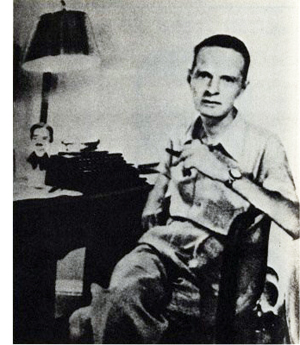 Cornell Woolrich is usually treated as an author with a uniquely haunting voice. Alcoholic and homosexual, he lived for decades in a hotel with his mother. After she died, he lost a leg to untreated gangrene. He dedicated one book to the typewriter on which he pounded out pulp stories and thriller novels, the most famous of them published in the years 1940-1948. His tales of suspense cultivated a hothouse morbidity. At his limit, Woolrich projects a paranoid vision of life without hope and death without dignity.
Cornell Woolrich is usually treated as an author with a uniquely haunting voice. Alcoholic and homosexual, he lived for decades in a hotel with his mother. After she died, he lost a leg to untreated gangrene. He dedicated one book to the typewriter on which he pounded out pulp stories and thriller novels, the most famous of them published in the years 1940-1948. His tales of suspense cultivated a hothouse morbidity. At his limit, Woolrich projects a paranoid vision of life without hope and death without dignity.
Despite his distinctive sensibility, Woolrich epitomizes some broader narrative strategies of his time. Like all popular writers, he inherited situations, techniques, and themes. To present a bleak, aching world of precarious love and doomed lives, he twisted those conventions into eccentric shapes that added to the Variorum of 1940s mystery storytelling.
For him, one bout of amnesia isn’t enough, so The Black Curtain (1941) doubles it: the hero, already having forgotten his previous identity, is clobbered by some falling bricks and now can’t remember who he just was. The prototypical serial killer of the 1940s is a man, but The Bride Wore Black (1940) lets a woman stalk her victims. Most thriller novelists are content to put one woman in jeopardy per book, but Black Alibi (1942) lines up six. Alternatively, when a woman tries to save her husband from the chair by investigating four suspects, she’s plunged into danger every time she meets one (The Black Angel, 1943).
Woolrich’s plots flout police procedure (his cops are exceptionally willing to help suspects), and the authorities often flounder. Suspense thrillers usually invoke the supernatural only to dispel it, but in Night Has a Thousand Eyes (1945) the authorities fail to save a life because one old man really can predict the future. Not that amateur sleuths fare much better. The unheroic hero of The Black Path of Fear (1945) could hardly be more ineffective; he has to be rescued by the Havana police.
Sometimes the straining for originality snaps. Critics have long pointed out improbabilities and contradictions in the plots. Woolrich’s most devoted chronicler, Francis M. Nevins, warns of “chaotic ambiguities.” The chronology of Rendezvous in Black (1948) is impossible, while the climactic revelation of I Married a Dead Man (1948) is arguably incoherent. Convenient coincidences abound. Add to this a hypertrophied style that in every book slips into unabashed weirdness. (See above.)
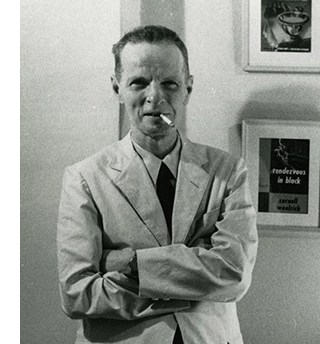 Both the plot problems and the vagaries of language can partly be attributed to the rush of Woolrich’s production, his transport while hammering at his Remington Portable. Pulp author Steve Fisher recalled: “Sitting in that hotel room he wrote at night—continuing through until morning, or whenever the story was finally completed. He did not revise, polish, and I suspect did not even read the story over once it was committed to paper.” Although Woolrich was grateful to editors who corrected his hundreds of errors in spelling and punctuation, he apparently resisted efforts to touch up his prose. When an editor suggested a change to a single paragraph, he replied, “I knew you wouldn’t like it,” and left the publisher forever.
Both the plot problems and the vagaries of language can partly be attributed to the rush of Woolrich’s production, his transport while hammering at his Remington Portable. Pulp author Steve Fisher recalled: “Sitting in that hotel room he wrote at night—continuing through until morning, or whenever the story was finally completed. He did not revise, polish, and I suspect did not even read the story over once it was committed to paper.” Although Woolrich was grateful to editors who corrected his hundreds of errors in spelling and punctuation, he apparently resisted efforts to touch up his prose. When an editor suggested a change to a single paragraph, he replied, “I knew you wouldn’t like it,” and left the publisher forever.
Admiring readers excuse the faults by testifying that Woolrich’s evocation of tension keeps the pages turning. “Headlong suspense created by total, unrelieved anxiety,” noted Jacques Barzun. “Breathless reading is the sole pleasure.” Raymond Chandler called him the “best idea man” among his peers, but admitted, “You have to read him fast and not analyze too much; he’s too feverish.”
What keeps us reading? For one thing, the outré story situations. A couple hurrying to leave New York must clear the man of murder before the bus leaves (Deadline at Dawn, 1945). A killer stalks a city, but it’s not a human: it’s (apparently) a black jaguar escaped from a sideshow (Black Alibi). A mail-order bride seems unacquainted with things she wrote in her letters (Waltz into Darkness, 1947). Most famously, a man laid up in his apartment thinks he sees traces of a killing through a window across the courtyard (“Rear Window,” 1942).
Outrages to plausibility carry their own allure. What, we ask, might come of these wild mishaps? A train crash kills a husband and his pregnant wife. In the melée an abandoned woman, also pregnant, is mistaken for her and welcomed by the husband’s family. Conveniently, the in-laws have never seen the wife (I Married a Dead Man, 1948) A man accused of murder has an alibi, to be provided by a woman he met in a bar and took to a show. Trouble is, she’s vanished. All the witnesses deny she existed (Phantom Lady, 1942).
The development of the action also presents intriguing reversals. The man gulled by the fake mail-order bride falls in love with her. People who claim not to have seen the phantom lady wind up dead. The woman trying to exonerate her husband falls in love with the real killer and dreams about him even after he has killed himself.
The game is afoot
Woolrich’s novels tend to rely on two basic plot patterns, both based on the hunt. In one, amateurs try to solve a crime and move from suspect to suspect. Our viewpoint is mostly tied to the investigators. In the other pattern, a serial killer stalks a string of victims, and here Woolrich is more innovative. Normally, the serial-killer plot either concentrates on the killer’s viewpoint, as in the novels Hangover Square (1941) and In a Lonely Place (1947), or concentrates on the investigators, as in Ellery Queen’s Cat of Many Tails (1949). A few constantly bounce the spotlight among all the parties—killer, victims, and investigators—as in Fritz Lang’s film M (1931) and Philip MacDonald’s novel X v. Rex (1933).
Woolrich by contrast emphasizes the victims’ viewpoints. The killer might appear only at the beginning and end (Rendezvous in Black) or get introduced at intervals in brief, objective scenes (The Bride Wore Black). Less space is devoted to the investigators, although they gain prominence as the crimes pile up. Woolrich puts his energies into building waves of suspense as one target after the other confronts death.
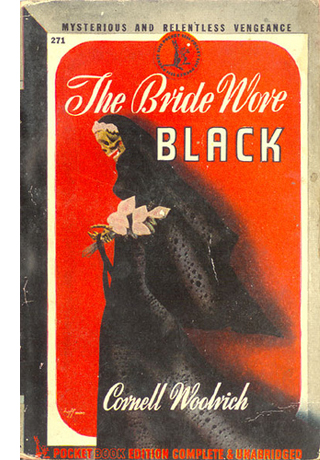 The shooting-gallery structure enables Woolrich to fulfill Mitchell Wilson’s demand that the thriller devotes its energies to showing what fear feels like. The 1940s interest in intense subjectivity of narration helps out here, and Woolrich sustains it in detailed description of victims’ reactions. In Black Alibi, Teresa is being stalked by an unseen figure.
The shooting-gallery structure enables Woolrich to fulfill Mitchell Wilson’s demand that the thriller devotes its energies to showing what fear feels like. The 1940s interest in intense subjectivity of narration helps out here, and Woolrich sustains it in detailed description of victims’ reactions. In Black Alibi, Teresa is being stalked by an unseen figure.
Something else now assailed her, again from without herself, but of a different sensory plane than hearing this time. A prickly sensation of being watched steadily from behind, of something coming stealthily but continuously after her, spread slowly like a contraction of the pores, first over the back of her neck, then up and down the entire length of her spine. She couldn’t shake it off, quell it. She knew eyes were upon her, something was treading with measured intent in her wake.
This passage is part of a ten-page account of the woman’s wary progress through a night street, rendered wholly from her viewpoint.
Woolrich’s other basic plot pattern, the investigation of a murder, plays up the role of fear as well. His amateur detectives, lacking official firepower, are constantly facing danger from the suspects they track.
Fright was like an icy gush of water flooding over them, as from burst pipe or water-main; like a numbing tide rapidly welling up over them from below. [Deadline at Dawn]
In both of his favored plot schemes, the plunges into characters’ minds and bodies help fill out a full-length novel. If you play down other lines of action (professional police investigation, killer’s mental life), you need to dwell on the reactions of the victims or amateur detectives.
Yet this very emphasis is one source of the stylistic howlers. In expanding his suspense scenes, Woolrich’s prose sometimes fails him. Needing to spin out lots of words evoking an ominous atmosphere, he’s tempted to pileups like this:
And the path that had led me to it through the night had been so black and so full of fear, and downgrade all the way, lower and lower, until at last it had arrived at this bottomless abyss, than which there was nothing lower. [The Black Path of Fear]
Such rodomontade carries the 1940s emphasis on subjectivity to paroxysmic limits.
He recruits other techniques of popular storytelling. They keep his action moving forward through time and plunging inward into the unfolding scenes. And some can help mask story problems.
By hinging his story around a search for a killer or a victim, Woolrich’s plots tend create a string of one-on-one encounters. Rather than disguising the episodic quality of these, he sharpens them by breaking the action into distinct blocks. Those blocks are presented as a checklist agenda, Woolrich’s equivalent to the closed circle of suspects we find in the classic weekend-house-party detective story.
The Black Angel is a simple instance.
After an initial cluster of five chapters presenting Kirk Murray sentenced to death, we follow Kirk’s wife Alberta as she seeks the true killer. Her efforts are given in five parallel chapters, each indented and tagged with a telephone number. One that Alberta finds scratched out in an address book is presented just that way in the chapter title: “Crescent 6-4824.” Because at the climax she returns to one of the four suspects, another title gets recycled: “Butterfield 9-8019 Again (And Hurry, Operator, Hurry!).”
A more complicated example of modularity is The Bride Wore Black. It’s broken into five parts, each titled with the name of a victim. Each part contains three sections.
“The Woman” shows the vengeful bride launching a new false identity. The part’s second section, titled with the victim’s name, shows how the murder is accomplished. A third section offering “Post-Mortem” on the victim consists of documents and conversations among the police. Viewpoints are rigidly channeled as well. Each “Woman” section is handled in objective description, while each victim section presents the targeted man as the center of consciousness. The book could be mapped out on a spreadsheet.
The modular layout and rigorous moving-spotlight narration risk choppiness, yielding something like a set of short stories. But the tidy exoskeleton can make the plot seem rigorously organized, even while it masks problems of time and causality. And the very arbitrariness of the pattern creates a sort of meta-curiosity. Like the teasing tables of contents in 1920s and 1930s detective fiction, a Wooolrich checklist of suspects or victims makes us aware of a larger rhythm. How will this pattern be filled out?
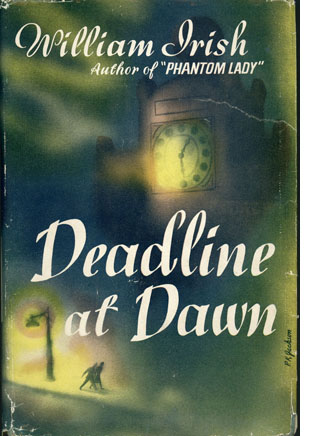 An overarching unity is provided as well by the demands of a deadline (another Hollywood-friendly feature). Thanks to this classic device, Woolrich can use time tags to trigger anticipation and yield a sense of shape. Long before the husband in Phantom Lady gets accused of the crime, the first chapter bears the title, “The Hundred and Fiftieth Day before the Execution,” effectively dooming him from the start. Deadline at Dawn replaces chapter titles with illustrated clock faces to impose a strict structure.
An overarching unity is provided as well by the demands of a deadline (another Hollywood-friendly feature). Thanks to this classic device, Woolrich can use time tags to trigger anticipation and yield a sense of shape. Long before the husband in Phantom Lady gets accused of the crime, the first chapter bears the title, “The Hundred and Fiftieth Day before the Execution,” effectively dooming him from the start. Deadline at Dawn replaces chapter titles with illustrated clock faces to impose a strict structure.
Facing a ticking clock wedded to a clear-cut pattern, we become sensitive to variations among the modules. The victim-centered chapters of The Bride contrast the personalities and private lives of the male victims, along with Julie’s resourceful methods of murder, and the last chapter breaks the three-part format by inserting a flashback dramatizing the fatal wedding. Rendezvous in Black revives the shooting-gallery structure of Black Angel and The Bride, adding a schedule that sets each murder on May 31st of different years. Within this regularity (“The First Rendezvous,” etc.), viewpoints multiply gradually so that the interplay of characters’ range of knowledge becomes richer.
The modular structure shows up in milder ways. Black Alibi tags its chapters with victims’ names and concentrates on one woman’s terror at a time, with each chapter concluding with an exchange among investigators. Deadline at Dawn and Phantom Lady alternate scenes between two characters embarked on parallel investigations. Night Has a Thousand Eyes, in some ways the most ambitious of the books, embeds the checklist within the police investigation. As teams of cops trace parallel leads, their efforts are crosscut with the target under threat, waiting with his daughter and a cop.
A simpler, more poignant, rhyme-and-variations effect is supplied by a prologue and epilogue in I Married a Dead Man. The prologue’s first-person narration, set off from the central chapters’ third-person narration, finishes: “We’ve lost. That’s all I know. We’ve lost, we’ve lost.” An epilogue rewrites the prologue and yields closure: “We’ve lost. That’s all I know. And now the game is through.” In such ways, Woolrich brings the overt compositional symmetry of both “serious literature” and the puzzle-driven detective story into the thriller.
Sweating the small stuff
Henry James, 1913; Cornell Woolrich, ca. 1927.
By the 1920s, ambitious Anglo-American writers in both popular genres and “advanced” literature had fallen under the sway of a new model of the novel. Henry James had argued that if the novel was to be a true art form, it needed more compositional rigor, a patterned architectural solidity. He also advocated for a self-conscious control of viewpoint and a greater commitment to concrete presentation of action. (“Dramatize, dramatize!”) A little later, Joseph Conrad’s books had demonstrated the power of shifting viewpoints and multiple narrators, as well as an emphasis on the power of sight.
Popular writers of the nineteenth century, notably Dickens and Wilkie Collins, had already made use of some of these techniques, as did more highbrow efforts, like Robert Browning’s verse novel The Ring and the Book (1868-1869). But in the wake of James and Conrad, tastemakers erected these principles into strict norms for well-made novels. These precepts were set out explicitly in Percy Lubbock’s The Craft of Fiction (1922), and they were picked up in popular writing manuals as well.
Many mainstream fiction writers (and dramatists) took up the techniques promoted by the James-Conrad-Lubbock tradition. Middlebrow novels employed block construction, played with multiple viewpoints, and included an explicit “exoskeleton” of labeled parts pointing up a self-conscious architecture. Joseph Hergesheimer’s Java Head (1919) spreads nine characters’ viewpoints across ten parallel chapters. Detective fiction wasn’t immune to the new methods. Conrad’s exploration of optical viewpoint has a contemporary counterpart in the Chestertonian grandeur of the mystery story “The Hammer of God” (1910). Father Brown is standing at the top of a church.
Immediately beneath and about them the lines of the Gothic building lunged outwards into the void with a sickening swiftness akin to suicide. . . . When they saw [the church] from below, it sprang like a fountain at the stars; and when they saw it, as now, from above, it poured like a cataract into a voiceless pit.
The writers of High Modernism revised the James-Conrad-Lubbock norms, pushing toward more difficult manipulations of time, viewpoint, and subjective states. Faulkner’s The Sound and the Fury assigns different narrational voices to its four-block layout, but these make the story world and the time scheme opaque. (Even if you master the stream-of-consciousness technique, you still have to figure out that one character is called by two names and two characters have the same name.)
Like many other writers, Woolrich pulls several post-James techniques into genre literature. His block construction, marked by strict times and viewpoints, along with his labeling of plot phases, owes something to this tradition, as well as to the clever construction of detective stories of the 1920s and 1930s (Ellery Queen, Anthony Berkeley, et al.). He borrows another narrative strategy as well: granular scene description keyed to a character’s sensations and feelings. We get a kind of hypertrophy of Lubbock’s “Show, don’t tell.” In reply to James, Woolrich in effect declares, “Overdramatize, overdramatize!”
In his uncompleted autobiography, Woolrich reflected on his early efforts to compose scenes. A man takes a hotel elevator, and instead of writing, “He got in, the car started; the car stopped at the third and he got out again,” the young Woolrich would pad the trip out to a page or more. This was amateurish, he thought at the end of his life. Yet this sort of expansion of action moment by moment is a hallmark of his 1940s novels. Perhaps it’s what Chandler had in mind when referred to Woolrich “getting deep into every scene.”
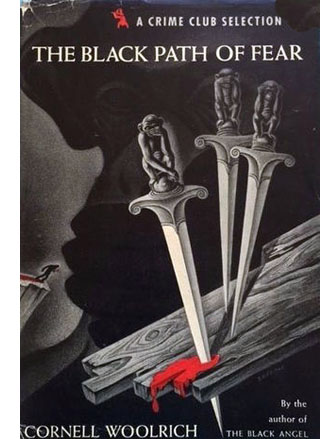 As we’ve seen, moments of terror and suspense are rendered in detail. So are the necessary touches of atmosphere. In The Black Path of Fear, the man on the run has told his story to Midnight.
As we’ve seen, moments of terror and suspense are rendered in detail. So are the necessary touches of atmosphere. In The Black Path of Fear, the man on the run has told his story to Midnight.
When I’d finished telling it to her the candle flame had wormed its way down inside the neck of the beer bottle, was feeding cannibalistically on its own drippings that had clogged the bottle neck. The bottle glass, rimming it now, gave a funny blue-green light, made the whole room seem like an undersea grotto.
We’d hardly changed position. I was still on the edge of her dead love’s cot, inertly clasped hands down low between my legs. She was sitting on the edge of the wooden chest now, legs dangling free. . . .
The behavior of light, the insistence on color, the description of the characters’ postures and gestures—these are typical of Woolrich’s scenes.
Even the simplest action employs Lubbock’s “scenic method” to a disconcerting degree. To quote adequately would take pages, but some samples can suggest just how distended and detailed even minimally functional scenes are.
I reached out for a little lamp he had there close beside the bed and clicked it on. Twin halos of light sprang out, one at each end of the shade, and showed up our faces and a little of the margin around them. The shade itself was opaque, to rest the eyes.
Then I just sat back and waited for the shine to percolate through to him, sitting on the bias to him. It took some time. He was sleeping like a log. [The Black Path of Fear]
Any other writer would have retained just the first sentence and the last (but maybe not with the clichéd phrasing). Who cares about the design of a light fixture, or whether the shade rests the eyes? Yet Woolrich feels the need to show and tell as much as he has room for.
A woman comes to a Bowery bar looking for a murder suspect. After a page and a half of banter with the bartender, she finds her quarry hunched over a tabletop. Another page is devoted to rousing him.
He moved slightly, and I saw him looking downward at the floor around his feet. Looking around for something on that filthy place where people stepped and spat all day long. In a moment more I had guessed what he was looking for and I opened my handbag and took out the cigarettes I had provided myself with and held the package ready, with one protruding, as my first silent overture.
His eyes stopped roaming suddenly, and they had found the small arched shape of my shoe, planted there unexpectedly on that floor beside him, and the tan silk ankle rising from it. [The Black Angel]
It takes another page for the drunk to accept the cigarette, and three more for the woman to question him. But he’s too incoherent, so she parks him in a hotel and resumes questioning him the next day—a process that takes fifteen pages and includes detailed descriptions of the hotel room, the light filtering in, and the two characters’ shifting positions in space.
This writer has Roderick Usher’s “morbid acuteness of the senses.” Scenes are thick with smells and sounds. One virtuoso section of Rendezvous in Black is all noises and speech because our center of consciousness is a blind woman. Above all, Woolrich’s scenes revel in optical point of view.
Movies on the page
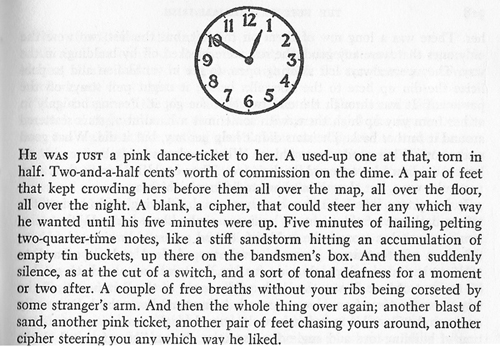
Sometimes the observer is imaginary, looking at things alongside the character. Detective Wanger enters a murder scene.
They seemed to be playing craps there in the room, the way they were all down on their haunches hovering over something in the middle of the floor. You couldn’t see what it was, their broad backs blotted it out completely. It was awfully small, whatever it was. Occasionally one of their hands went up and scratched the back of its owner’s rubber-tired neck in perplexity. The illusion was perfect. All that was missing was the click of bone, the lingo of the dicegame. [The Bride Wore Black]
Actually, the policemen are interrogating a boy whose father has been murdered. Presumably Wanger doesn’t take the huddle for a craps game. We’re given the mistaken impression of a novice observer who’s watching from a particular angle.
More often, it’s the character who occupies a definite station point, determined by foreshortening and perspectival distortion. The supreme example is of course the short story “Rear Window” (1942) whose original title was “Murder from a Fixed Viewpoint.” One of his clumsy passages in another story tries for the same kind of positioning: “He turned and looked up, startled, ready to jump until he’d located the segment of her face far up the canal of opening between them.”
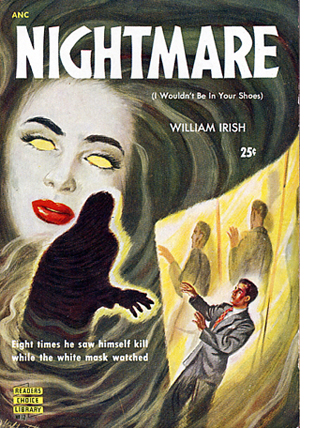 Woolrich’s interest in the geometry of looking, what can and can’t be seen, finds a natural home in eyewitness plots, of which there were several in 1940s film and fiction (and even radio). In “Rear Window,” the protagonist Jeff tracks his neighbor’s progress from window to window as if studying an Advent calendar. Woolrich strives to capture the exact geometry of Jeff’s field of view.
Woolrich’s interest in the geometry of looking, what can and can’t be seen, finds a natural home in eyewitness plots, of which there were several in 1940s film and fiction (and even radio). In “Rear Window,” the protagonist Jeff tracks his neighbor’s progress from window to window as if studying an Advent calendar. Woolrich strives to capture the exact geometry of Jeff’s field of view.
There was some sort of a widespread black V railing him off from the window. Whatever it was, there was just a sliver of it showing above the upward inclination to which the window sill deflected my line of vision. All it did was strike off the bottom of his undershirt, to the extent of a sixteenth of an inch maybe. But I hadn’t seen it there at other times, and I couldn’t tell what it was.
Jeff’s tightly focused attention contrasts with his neighbor Thorwald’s casual sweeping looks toward the courtyard. The climax will come when Thorwald realizes he’s been Jeff’s target, and Jeff sees in the murderer’s look “a bright spark of fixity” that “hit dead-center at my bay window.”
A similar effect occurs at the climax of “The Boy Cried Murder” (aka “Fire Escape”) of 1947, the source of the film The Window (1949). Buddy has been sleeping on a fire escape and is awakened by a murder he watches through a slit in the window shade. The woman comes toward him.
She started to come over to where Buddy’s eyes were staring in, and she got bigger and bigger every minute, the closer she got. Her head went way up high out of sight, and her waist blotted out the whole room. He couldn’t move, he was like paralyzed. The little gap under the shade must have been awfully skinny for her not to see it, but he knew in another minute she was going to look right out on top of him, from higher up.
Again, there’s a stylistic slip (of course she’ll be higher up if she looks out on top of him), but it’s a byproduct of an effort to capture a character’s optical viewpoint.
Sometimes that effort seems pure gimmickry.
I hurried down the street, and the intermittent sign back there behind me kept getting smaller each time it flashed on. Like this:
MIMI CLUB
Mimi Club
mimi club
I could tell because I kept looking back repeatedly, almost in synchronization with it each time it flashed on. . . . [The Black Angel]
Yet even the gimmick seems an effort toward a peculiar kind of vividness—that of a film. The passage imitates alternating shots of the woman looking and the withdrawing club sign. If Woolrich’s modular structure is indebted to strains in modernism and popular fiction, the dense, over-visualized scenes inevitably suggest cinema.
Woolrich worked as a Hollywood screenwriter for a few years and had a lifelong affinity for movies. The books often use cinematic analogies and metaphors, and the characters are frequent moviegoers. (In a 1936 story, “Double Feature,” a gangster takes a woman hostage in a projection booth.) Supposedly Woolrich spent his last years holed up drinking and watching old films on TV. No surprise, then, that some passages echo the look and feel of Hollywood scenes.
Granted, many writers, highbrow and lowbrow, were imitating cinema in Woolrich’s day. Some incorporated filmlike montage sequences to suggest dreams and stream of consciousness. But Woolrich goes farther than most. In Fright (1950), two paragraphs headed “Still Life” survey an empty room that shows signs of interrupted activity—a crumpled newspaper, a note, a burning cigarette, a swaying lamp chain. The passage mimics the sort of tracking shot over details we find in 1940s cinema, continuing for a page until it climaxes in a close-up panning over a body jammed against the door.
When a man realizes his beloved woman lies dead on the bed, a dash can imitate a cut:
But her eyes were still blurry with slee—
His hand stabbed suddenly downward toward the hairbrush, there before her. [Rendezvous in Black]
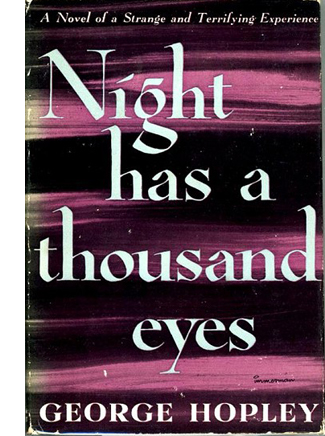 In Night Has a Thousand Eyes, a woman waits in her car while her father visits the telepath over a period of weeks. Each brief scene starts with the same imagery and phrasing, creating a string of rhyming “shots” across three pages.
In Night Has a Thousand Eyes, a woman waits in her car while her father visits the telepath over a period of weeks. Each brief scene starts with the same imagery and phrasing, creating a string of rhyming “shots” across three pages.
I sat there waiting for him, cigarette in my hand, light-blue swagger coat loose over my shoulders. . . .
I sat there waiting for him, rust-colored swagger coat loose over my shoulders. . . .
I sat their waiting for him, plum swagger coat over my shoulders. . . .
I sat there waiting for him, fawn swagger coat over my shoulders. . . .
I sat there waiting for him, green swagger coat over my shoulders. . . .
I sat there waiting for him, black swagger coat over my shoulders, as I’d already sat waiting so many times before.
The modular approach ruling the books’ overall architecture gets carried down into the texture of scenes, creating parallel mini-blocks that convey the daughter’s anxious acquiescence to her father’s obsession.
Woolrich’s literary optics have strong affinities with cinema. We get an effort to mimic a subjective tracking shot as one heroine circles a garden.
The little rock-pool in the center was polka-dotted with silver disks, and the wafers coalesced and separated again as if in motion, though they weren’t, as her point of perspective continually shifted with her rotary stroll. [I Married a Dead Man]
Likewise, a woman approaching a man slowly tapers into focus.
She was up to him eye to eye before he could even take her in in any kind of decent perspective. His visualization of her had to spread outward in concentric, radiating circles for those eyes, staring into his at such close-range.
Brown eyes.
Bright brown eyes.
Tearfully bright brown eyes.
Overflowingly tearful bright brown eyes.
Suddenly a handkerchief had come up to shut them off from his for a moment, and he was able to steal a full-length snapshot of her. Not much more. [The Black Curtain]
This is just showboating, but it’s uniquely Woolrich showboating.
The same goes for a passage struggling to describe people at a bar as if they were framed in the flattening view of a telephoto shot.
There were eight people paid out along it. They broke into about three groups, each self-contained, oblivious of the others, but he had to look close to tell where the divisions came in. Physical distance had nothing to do with it; they all stretched away from him in an unbroken line. It was the turn of the shoulders that told him. The limits of each group were marked by a shoulder turned obliquely to those next in line beyond. They were like enclosing parentheses, those shoulders. In other words, the end men in each group were not postured straight forward, they turned inward toward their own clique. The groupings broke thus: first three, then a turned shoulder, then three again, then another turned shoulder, then finally two, standing vis-à-vis. [Deadline at Dawn]
Few writers would strive so hard to capture the exact look of figures in space. It will take another page for the viewpoint character to realize that a left-handed drinker has stepped out, because one beer mug isn’t empty and the handle is pointing in a different direction than the others.
It’s not hard to imagine such scenes as Hitchcockian POV shots. In Waltz into Darkness, Durand notices a colonel and his lady in the reflection of the “thick, soapy greenish” window of a café. At first the view yields a blob sporting “three detached excrescences”: a feather in a hat, a bustle, and “a small triangular wedge of skirt.” Eventually this monstrosity draws away “into perspective sufficient to separate into two persons.” Conrad’s “impressionism,” aiming to capture the limits of physical point of view, reaches a new height with Woolrich’s account of exact but imperfect vision.
Some provisional answers to my Woolrich questions run like this. The ingenuity of structure and the inherent fascination of the situations somewhat offset the problems of style. Most of his novels tap our primal interest in the hunt, and if things don’t always pay off neatly, the pursuit has enough detours, hurdles, and pitfalls to sustain interest.
And the writing isn’t totally disastrous. There are well-written passages in every Woolrich novel. Many of the howlers arise from the keyed-up emotion he tries to squeeze out of every scene. Others stem from sheer overwriting and padding, and probably the habit Fisher notes of seldom revising. But other errors are a byproduct of his effort to put every bit of action starkly before us. Straining for sensory vividness lures him into clumsiness (“triangular wedge,” as if all wedges weren’t triangular).
More generally, in both virtues and faults, he displays a dogged, frenzied obedience to the narrative traditions he inherited, and an urge to innovate within them, however eccentrically. Henry James asserted that “a psychological reason is, to my imagination, an object adorably pictorial.” A Woolrich character puts it in a typically convoluted way: “Every time you think of anything, there’s a picture comes before you of what you’re thinking about.”
Beyond the books of Nevins and Renzi, valuable appreciations of Woolrich include Nevins’ essay in his collection Cornucopia of Crime: Memories and Summations (Ramble House, 2010), 53-71; Geoffrey O’Brien’s comments in Hardboiled America: Lurid Paperbacks and the Masters of Noir, second ed. (Da Capo, 1997), 97-100; and James Naremore’s essay on his site, “An Aftertaste of Dread: Cornell Woolrich in Noir Fiction and Film.” For a topical overview of Woolrich’s output, see Mike Grost’s entry on him.
I took Steve Fisher’s account of Woolrich’s writing process from “I Had Nobody,” The Armchair Detective 3, 3 (1970), 164. The quotation from Jacques Barzun comes from Barzun and Wendell Hertig Taylor, A Catalogue of Crime, rev. ed. (New York: Harper & Row, 1989), 561. The Raymond Chandler remarks appear in a 1949 letter to Alex Barris in Raymond Chandler Speaking, ed. Dorothy Gardner and Kathrine Sorley Walker (Plainview, New York: Books for Libraries, 1971), 55. I’ve discussed Mitchell Wilson’s essay, “The Suspense Story,” The Writer 60, 1 (January 1947) at greater length in the online essay “Murder Culture.” More generally, Woolrich’s narrative strategies accord with several I chart in Reinventing Hollywood: How 1940s Filmmakers Changed Movie Storytelling, including the notion of the Variorum.
Woolrich’s early, Fitzgerald-influenced novels reveal seeds of the style to come. A random page from Manhattan Love Song (1932) yields a scene of the hero talking to two women: “Instantly I saw a gleam of admiration light each of their four eyes.”
Astonishingly, Woolrich’s prose glitches don’t rate a mention in Bill Pronzini’s hilarious compilations of bad writing, Gun in Cheek: A Study of “Alternative” Crime Fiction (Coward McCann, 1982) and Son of Gun in Cheek (Mysterious Press, 1987). Pronzini tactfully limits his citations of the classics, only mentioning one Raymond Chandler line: “In spite of his weathered appearance, he looked like a drinker.” Pronzini can find no faults in my personal Style canon: Rex Stout, Donald Westlake (here and here), and Patricia Highsmith.
There’s more on these issues in the entry “The 1940s are over, and Tarantino’s still playing with blocks.” I discuss The Window in “The eyewitness plot and the drama of doubt.”
When worlds collide: Mixing the show-biz tale with true crime in ONCE UPON A TIME . . . IN HOLLYWOOD
Once Upon a Time . . . in Hollywood.
Jeff Smith here:
Once Upon a Time…in Hollywood might turn out to be the buzziest film of 2019. Some of this water-cooler talk is due to its unusual status within an ever-enlarging field of true crime stories. (Call it a “not quite true” crime story.) Indeed, the genre is hotter than ever thanks to a bevy of new podcasts, telefilms, and miniseries.
Industry analysts, though, are also keen to interpret Once Upon a Time…in Hollywood’s box office fortunes. As that rare big summer release that is neither a sequel nor a franchise title, it can be seen as a test of whether original content can survive amidst heavily marketed, presold tentpoles.
The lesson so far? To quote William Goldman, “Nobody knows anything.” In The Washington Post, one unnamed studio executive warned, “I don’t see any blue-sky meaning here.” The executive added, “This movie has assets that almost no other film has. That’s what drove it.” At least one of those assets is Tarantino himself, who is a brand, if not a franchise. Fans know what to expect in a Tarantino film, which is why the film is sui generis when it comes to this summer’s slate. Due to its unique IP, it can’t really be compared with films like Men in Black International or Spider-man: Far from Home. Yet thanks to Tarantino’s larger than life presence, it also isn’t Long Shot or Booksmart or Stuber.
Once Upon a Time…in Hollywood is catnip to Tarantino nerds like me. It has the usual surfeit of references to obscure films and television shows. Some of these are deftly interwoven into the story itself. It boasts a carefully curated soundtrack that unearths “some-hits” wonders. It also contains scenes depicting nasty yet comical violence, a hallmark of Tarantino’s work ever since Reservoir Dogs.
At first blush, Once Upon a Time…in Hollywood would seem to be Tarantino’s most linear film. Yet it still displays certain continuities with his oeuvre in terms of story structure and technique. Although the film eschews the chapters and title cards found in Pulp Fiction and Kill Bill, it still contains elements of what David calls “block construction.” In the case of Once Upon a Time…in Hollywood, it is all about threes. The plot is structured around three days in the winter and summer of 1969: February 8th, February 9th, and August 9th. Each “chapter” is introduced showing the date via superimposed text. And all three chunks of narrative crosscut among the activities of three actors – Sharon Tate, Rick Dalton, and Cliff Booth – as they try to adapt to changes in the film and television industries.
If all of this assures that you’d never mistake Once Upon a Time…in Hollywood as the work of another director, other elements show Tarantino striking out in new directions. Chief among these is his mash-up of two normally distinct story types: the show-biz tale and the true crime yarn. Think of it as Singin’ in the Rain meets In Cold Blood. In what follows I outline some of the ways that Tarantino adapts his signature style to two well-established storytelling options: the multiple draft narrative and the network narrative. I also consider the effects Tarantino’s counterfactual history has on the conventions of the show-biz tale and the celebrity biopic.
My analysis contains major spoilers. If you haven’t seen Once Upon a Time…in Hollywood, stop reading now!
My world and welcome to it
Quick trivia question: what actor was on the cover of TV Guide during the week that Sharon Tate was murdered by the Manson family? Sharp viewers of Once Upon a Time…in Hollywood should know the answer. We see Tate’s housemate, Woychiech Frykowski, reading that issue of the magazine as he watches Teenage Monster on late night television.
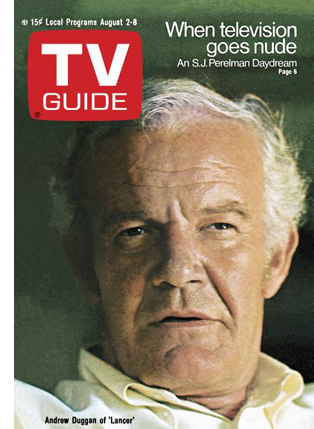 Give up? It was character actor Andrew Duggan, who played the cattle baron Murdoch Lancer on the TV show of the same name. Yes, that Lancer! The same one that featured Rick in a guest spot some six months earlier.
Give up? It was character actor Andrew Duggan, who played the cattle baron Murdoch Lancer on the TV show of the same name. Yes, that Lancer! The same one that featured Rick in a guest spot some six months earlier.
Tarantino’s film treats this little bit of pop culture ephemera as an uncanny coincidence. It simply becomes yet another way that he can intertwine the destinies of his three protagonists. But that brief shot got me thinking: did Tarantino start with the idea that he’d recreate whatever series was featured on TV Guide the week Tate was killed?
If so, Rick might have appeared just as easily as an aspiring cartoonist next to William Windom on the NBC sitcom, My World and Welcome to It. The show debuted just six weeks after Tate’s death. It is not unthinkable that NBC would have pushed for a cover on TV Guide in an effort to promote the premiere. Yet Tarantino’s counterfactual history in Once Upon a Time…in Hollywood would have been vastly different if that had been the case.
Did Tarantino really base his screenplay on this conceit? I doubt it. Lancer fits so snugly into the world that the director captures onscreen that it is not be so easily replaced. Tarantino seems to have a nostalgic fondness for the show, much as I did in my wasted youth. (I recall having a Lancer lunchbox at age six.) Production designer Barbara Ling describes the steps she took to recreate Lancer’s mix of Spanish/Western design. This involved adding adobe storefronts to the wooden ones, and substituting iron coils for wooden pegs on the saloon’s staircase. Ling added, “This was a [rich] cattle town and the buildings are two and three stories. It’s not Deadwood.”
Many critics have characterized Once Upon a Time…in Hollywood as another hangout movie. This is Tarantino’s designation for a film that is leisurely paced, fairly light on plot, and mostly gives the audience a chance to spend time with the characters. Indeed, because of these qualities, reviewers often compare Once Upon a Time…in Hollywood to Jackie Brown, a film that Tarantino himself compared to Rio Bravo, which was Howard Hawks’ hangout movie.
The resemblances don’t stop there. Once Upon a Time…in Hollywood’s three-headed protagonist bears certain similarities to Jackie Brown’s Jackie, Ordell, and Max.
Yet while watching Once Upon a Time…in Hollywood, I felt this film, more than any of Tarantino’s others, was an exercise in world-building. Normally we associate that term with sci-fi, fantasy, and comic book movies. It is especially important for transmedia properties where the fictional universe depicted exceeds the bounds of any individual film, television series, book, or video game.
Once Upon a Time…in Hollywood is also an alternate history, a type of speculative fiction also common in sci-fi and comic book stories. The Avengers: End Game and Spider-man: Into the Spiderverse are both relatively recent examples. This suggests a loose affiliation between Once Upon a Time…in Hollywood and other blockbusters even as Tarantino tweaks that formula by situating his speculative fiction within the generic framework of true crime.
Tarantino largely avoids the industrial motivations behind these two narrative techniques commonly seen in tentpoles. Instead, he simply recreates the pop culture world of his youth. In doing so, the director’s real world, his “realer than real” universe, and his “movie movie” universe all collide.
Keepin’ it real (and realer)
As Tarantino has explained in interviews, the “realer than real” universe is an alternate reality close to our own where his fictional characters can intermingle with real people. The “movie movie” universe, on the other hand, is a more overtly fantastic world closer in spirit to comic books or exploitation films. The characters have unusual abilities or even supernatural powers. The “movie movie” thus downplays the realistic motivations usually found in the “realer than real.” In Tarantino’s oeuvre, Reservoir Dogs and True Romance exemplify the “realer than real.” Kill Bill and From Dusk to Dawn are instances of the “movie movie.”
Each universe features a web of connections that can link particular tales together. For example, Kill Bill’s Sheriff Earl McGraw and his son Edgar pop up in Death Proof. Similarly, Lee Donowitz, the cocaine-sniffing movie producer in True Romance, is purportedly the son of Sgt. Donny Donowitz, the “bear Jew” in Inglourious Basterds.
In Once Upon a Time…in Hollywood, the most obvious references to these two Tarantino universes are the fictional brands he has created. During the end credits, we see Rick in a TV ad for Red Apple cigarettes. According to a Tarantino wiki, “ads or packs of these flavorful smokes” can be seen in The Hateful Eight, Inglourious Basterds, Planet Terror, Kill Bill, Pulp Fiction, From Dusk till Dawn, Four Rooms and Romy and Michele’s High School Reunion. (The latter is an obvious outlier. Yet the Red Apple nod was likely an in-joke related to Tarantino’s offscreen romance with Mira Sorvino, who played Romy.)
Similarly, Tarantino’s fictional fast food chain, Big Kahuna Burger, appears on a bus billboard in Once Upon a Time…in Hollywood. It previously was featured in a memorable scene in Pulp Fiction. (“That’s a tasty burger!”) But it had already debuted as a delicious snack devoured by Mr. Blonde in Reservoir Dogs. Big Kahuna later comes back in two other Tarantino films, From Dusk Till Dawn and Four Rooms, as well as Romy and Michele’s High School Reunion.
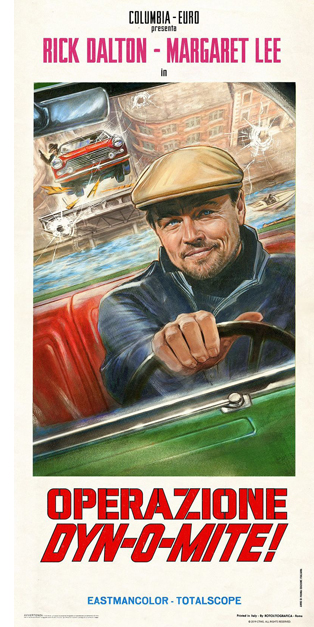 Other references to the “realer than real” are more arcane. In a montage sequence where Randy the Stuntman summarizes Rick’s experience starring in Italian films, we see a poster for Operazione Dy-no-mite, a James Bond knockoff directed by Antonio Margheriti. Fans of Inglourious Basterds will recognize “Antonio Margheriti” as the alias Donny Donowitz uses for the premiere of Nation’s Pride.
Other references to the “realer than real” are more arcane. In a montage sequence where Randy the Stuntman summarizes Rick’s experience starring in Italian films, we see a poster for Operazione Dy-no-mite, a James Bond knockoff directed by Antonio Margheriti. Fans of Inglourious Basterds will recognize “Antonio Margheriti” as the alias Donny Donowitz uses for the premiere of Nation’s Pride.
Much of the fun of Once Upon a Time…in Hollywood comes from the way Tarantino overlays these three universes to create a singular fictional world. For example, at one point we learn that Rick was considered for the role of Captain Virgil Hilts, the part played by Steve McQueen in John Sturges’ The Great Escape. Tarantino even inserts digitally altered footage of The Great Escape to show us a scene of Rick as Hilts. Since Rick claims he never met Sturges, this moment appears to represent an imagined version of the film that could exist in some type of alternate history. It invites us to consider how different Rick’s career might have been had fortune smiled upon him instead of McQueen.
To disentangle this knot, one must surmise that The Great Escape and Steve McQueen belong to both the real world and the “realer than real” world. Yet the scene of McQueen at the Playboy mansion and Rick describing his missed opportunity can only belong to the “realer than real.” And the character of Hilts himself exists only in the “movie movie” world. Hilts shares this status along with other characters Rick plays onscreen, such as Bounty Law’s Jake Cahill and The FBI’s Michael Murtaugh. After all, movie magic enables Cliff Booth to stand-in for Rick for scenes involving physical action. That two actors can play the same character within the same scene suggests that fictional personae in cinema have a unique ontological status quite different from the real world.
Arguably, the scene where Sharon Tate watches herself in The Wrecking Crew raises even more vexing issues about what is real and what is fictional. Unlike the clip from The Great Escape, the theatre screening shows the real Sharon Tate playing the character Freya in The Wrecking Crew. The fictional Sharon Tate watches the real Sharon Tate, along with the rest of the Bruin Theater’s audience. Yet, because Margot Robbie only pretends to be Sharon Tate for Tarantino’s camera, she doesn’t really watch herself playing the role. Obviously, Robbie belongs only to the real world. Yet Sharon Tate, as both an actual person and a fictional character, inhabits both the real world and the “realer than real world.”
Here the film indulges the Bazinian conceit that cinema has indexical properties. While making The Wrecking Crew, the film camera captured an imprint of the real Sharon Tate that preserved her being beyond the reaches of time and even death. In Once Upon a Time…in Hollywood, this moment is both joyful and sad. The viewer imagines the thrill that Tate feels in watching herself on the big screen, basking in the glow of incipient stardom. Yet the delight we experience is colored by our knowledge of what happened to the Sharon Tate seen falling on Dean Martin’s camera case. Unlike Robbie’s character, that Tate is doomed to a grisly death at the hands of psychopaths.
By film’s end, however, we are forced to reevaluate where Sharon Tate fits into Tarantino’s universe. When Cliff and Rick thwart the attack of Tex Watson, Susan “Sadie” Atkins, and Patricia “Katie” Krenwinkel, both Sharon Tates appear to move solely to the realm of the “realer than real.” Like the fictional Sharon Tate played by Robbie, the actress who appeared in The Wrecking Crew also lives on in a parallel universe created by the forking of time. And the fate of that character remains completely undetermined. Now fully a part of the “realer than real,” Tarantino’s Sharon Tate might eventually snort cocaine with movie producer Lee Donowitz or bum a Red Apple cigarette from Pulp Fiction’s Mia Wallace.
Once she joins the “realer than real,” almost any fate you could imagine for Sharon Tate seems possible. And it is that sense of the actress’ unlimited horizons that gives the ending of Once Upon a Time…in Hollywood its resonance. Sergio Leone’s Once Upon a Time films always situated viewers in the realm of myth. Once Upon a Time…in Hollywood, on the other hand, evokes the fairy tale.
Tarantino is known for his experimentation with narrative, and the simplicity of Once Upon a Time…in Hollywood’s “what-if” scenario could seem like a retreat from the formal play seen in his earlier films. Yet I’d argue that Tarantino’s merging of fact and fiction is even more audacious in certain respects. It strikes me as an unconventional example of what David calls “multiple draft narratives,” like Krzystof Kieslowski’s Blind Chance or Peter Howitt’s Sliding Doors. Once Upon a Time…in Hollywood gives us a second draft of history, albeit one where the key decision point is saved almost until the end of the film. And unlike Blind Chance or Sliding Doors, Tarantino doesn’t need to tell us what the different outcomes are for each of these tales. The first draft of history is one we already know.
In fact, the notion of multiple drafts offers a useful lens for all three films in Tarantino’s “counterfactual” trilogy. (The other two are Inglourious Basterds and Django Unchained.) In Groundhog Day, Source Code, and Edge of Tomorrow, each iteration of the basic situation shows the protagonist inching toward his goals. They gradually progress to the point where they are able to alter destiny, either theirs or the world’s or both.
Inglourious Basterds, Django Unchained, and Once Upon a Time…in Hollywood all present images of history not as it was, but as it should have been. Such counterfactual histories run counter to the norms of speculative fictions that often present us with dystopian worlds we were lucky to avoid. (Think Philip K. Dick’s The Man in the High Castle, Robert Harris’ Fatherland, or Kevin Willmott’s “mockumentary” C.S.A.: The Confederate States of America.) All of these stories depend upon our knowledge of the first draft of history. Yet Tarantino gives us second drafts that right particular historical wrongs in either small or large measure. In doing so, Tarantino gives us versions of history that are closer in spirit to his favorite movies. All three films in the “counterfactual” trilogy feature tidy resolutions. Once Upon a Time…in Hollywood, however, is even more self-conscious about the way Tarantino’s second draft of history takes the form of a “movie movie” climax. The realer-than-real version is the one we ought to prefer.
Paging Mr. Melcher, Mr. Terry Melcher…
If Tarantino’s conflation of fact and fiction evokes certain traits of the multiple-draft narrative, his vivid recreation of Hollywood circa 1969 illustrates another type of story popularized in American independent films and various art cinemas: the network narrative.
Tarantino has broached this form before in Inglourious Basterds. There he moves back and forth between three mostly independent storylines: 1) the Basterds’ guerrilla campaign against German soldiers, 2) Archie Hicox and Bridget von Hammersmarck’s initiation of Operation Kino, and 3) Shosanna’s plan to avenge her family’s deaths during the premiere of Nation’s Pride. SS officer Colonel Hans Landa threads through all three storylines. He orders the killing of Shosanna’s family in the opening scene. Later he shares apple streudel with Shosanna in a Paris café. Landa also investigates the scene where Hicox has been killed. In the climax, he interrogates Bridget in a scene that contains a grim allusion to Cinderella’s lost slipper.
Finally, Landa negotiates a deal with Aldo Raine’s superiors that guarantees his immunity from prosecution for war crimes.
Once Upon a Time…in Hollywood is obviously much less plot-driven than Inglourious Basterds. Yet, as noted above, it shares a similarity in the way it interweaves the stories of three characters: Rick, Cliff, and Sharon.
It’s frequently said that Hollywood is a company town. By situating all three characters within the film and television industries, Tarantino tacitly stays faithful to that truism. The protagonists’ shared profession also facilitates the kinds of attenuated links between stories commonly found in network narratives.
Part of the fun of Once Upon a Time…in Hollywood comes in recognizing the “six degrees of separation” that join all of these people, both real and fictional, in the same entertainment ecosphere. Take, for instance, one decidedly minor character: actress and singer Connie Stevens, played by Dreama Walker. At the Playboy Mansion party, Stevens listens to Steve McQueen explain the romantic triangle that has Sharon living with her current husband, Roman Polanski, and her ex-boyfriend, Jay Sebring. Stevens, though, is the ex-wife of actor James Stacy, who played Johnny Madrid in Lancer. Stacy (played in our film by Timothy Olyphant) is Rick Dalton’s scene partner for the episode of Lancer that Dalton hopes can spur his comeback. Dalton is Sharon Tate’s neighbor on Cielo Drive, the same house that Charles Manson targets as the site of the “family’s” first murder. This circuit even loops back on itself. When Stacy and Dalton first meet on set, Stacy asks Rick whether it was true that he almost got a part in The Great Escape, the same part played by McQueen.
Two characters in Once Upon a Time…in Hollywood serve as nodes that connect all three storylines together. The first is Cliff, Rick’s stunt man and gofer. Although not a resident at Cielo Drive, he spends a lot of time in Rick’s home and thus is privy to what happens in Sharon’s abode. This is especially evident when Cliff repairs Rick’s fallen TV antenna. The camera is aligned with him as he overhears Sharon playing a Paul Revere and the Raiders album. He also notices Charles Manson approaching the Polanski residence. Tarantino’s casting of Damon Herriman as Manson is likely an allusion to the television show, Justified. Herriman played Dewey Crowe alongside Olyphant.
Justified was also an adaptation of Elmore Leonard’s “Raylan Givens” books. Tarantino has long admired Leonard’s work as a writer of both westerns and crime novels.
Employing a redundancy that befits Hollywood storytelling, Cliff gets linked to Sharon’s storyline in other ways. While working as Rick’s stunt man for an episode of The Green Hornet, he gets involved in a dust-up with Bruce Lee. Lee gave Sharon Tate some pointers on fighting as she prepared for her role in The Wrecking Crew. And in real life, the martial arts legend was recommended for the role of Kato on television’s The Green Hornet by Sebring, Tate’s former boyfriend.
Perhaps Cliff’s most important role in the film’s network involves his dalliance with Pussycat, one of the many young women who viewed Manson as a kind of guru. Cliff picks up Pussycat as a hitchhiker and gives her a ride back to the Spahn ranch. Having worked on the ranch back when it was an active production site, Cliff grows concerned for the safety of its owner, George Spahn. Cliff notices how the Manson clan has taken over and is troubled by its weird vibe. Determined to see George for himself, Cliff forces his way into George’s house over the objections of the Manson girls, especially Squeaky. George seems careworn, but Cliff finds that there is little he can do for him.
When Cliff sees a pocketknife sticking out of his front tire, he confronts Clem, one of Manson’s followers. The conflict becomes physical. Cliff breaks Clem’s nose with one punch and then proceeds to beat him to a bloody pulp.
This proves to be a dangling cause that gets resolved in the film’s climax when Cliff recognizes Tex, Sadie, and Katie as people he met at the Spahn ranch.
The other character who links the storylines together is one we never see: record producer Terry Melcher. Melcher is the “Terry” that Manson mentions when he visits Cielo Drive in the scene described above. Later, Tex reminds Sadie, Katie, and Linda that Charlie directed them to go to the place where Terry Melcher lived and kill everyone inside.
Although these are the only explicit references to Melcher, he is indirectly represented in several other aspects of the film. Here it helps to know a little about Melcher’s career and Manson lore. Even if Melcher’s name draws a blank, you likely know many of the bands he worked with: the Byrds, the Mamas and the Papas, and Paul Revere and the Raiders.
All these musicians crop up in one way or another in Once Upon a Time…in Hollywood. Melcher’s last major credit of the 1960s was as producer of the Byrds’ Ballad of Easy Rider. When Rick berates Tex for parking his car on Cielo Drive, he yells, “Hey, Dennis Hopper! Move this fucking piece of shit!” Rick’s insult fits with his general disdain for hippies. But it also alludes to Easy Rider by comparing Tex’s look to that of Hopper’s character, Billy.
Two of the Mamas and the Papas – Michelle Phillips and Cass Elliot – both appear in the party scene at the Playboy mansion.
We also hear the Mama and the Papas’ big hit, “California Dreaming” in a cover version by Puerto Rican singer José Feliciano. And when the car driven by Tex crawls up Cielo Drive, the music issuing from the Polanski residence is the Mamas and the Papas’ “12:30: Young Girls are Coming to the Canyon.” Even before Tex’s directive to the Manson girls, Tarantino has given us a subtle reminder that Melcher was Charlie’s intended, if indirect, target.
Finally, Sharon plays Paul Revere and the Raiders’ “Good Thing” and “Hungry” on a hi-fi in her bedroom.
The choice of music is especially fitting since the band’s lead singer, Mark Lindsay, lived in the same house on Cielo Drive with Melcher and his then girlfriend, Candice Bergen.
Beyond these musical references, Melcher’s history with Manson informs Once Upon a Time…in Hollywood in another way. Melcher recorded some demos of Manson’s songs, and even discussed making a documentary about Manson’s commune at the Spahn Ranch. In testimony at trial, Melcher said that any possibility of a record contract with Manson was sundered when Charlie asserted that he’d never join a musicians’ union. Manson’s staunch refusal was rooted in his desire to avoid entanglements with the establishment. Yet union membership was a condition for any contract with Melcher’s label, Columbia records. Another factor in Melcher’s decision was his assessment of Manson’s talent. Charlie couldn’t sing.
Although Melcher publicly stated that he only considered Manson’s musicianship, he privately expressed concerns about Charlie’s mental stability. These were heightened when he visited the Spahn Ranch and witnessed Manson in a physical altercation with a drunken stunt man. Tarantino more or less recreates this episode in his film, substituting Cliff for the unnamed stunt man and the hapless Clem for Charles Manson.
More importantly, Melcher is the son of screen legend Doris Day and stepson of agent/manager/producer Martin Melcher. In Once Upon a Time…in Hollywood, he becomes the ideal, if absent, symbol of the combined worlds of music, television, and film that Tarantino so lovingly details.
How the West was lost
Los Angeles circa 1969 is presented as the epicenter of the American entertainment industries. It’s a place where a hairdresser like Jay Sebring rubs shoulders with action stars, TV cowboys, ingénues, film directors, and pop stars –and make $1000 a day to boot! The constant stream of hits from KHJ radio is as ubiquitous as the many movie posters, billboards, and theater marquees that feature Hollywood’s latest and greatest.
Tarantino’s press kit for Once Upon a Time…in Hollywood makes reference to Joan Didion’s famous observation in “The White Album” that “the Sixties ended abruptly on August 9, 1969, at the exact moment when word of the murders on Cielo Drive traveled like brushfire through the community.” Most critics take Didion’s reference to the Sixties as shorthand for the end of the “peace and love generation.” Yet Tarantino’s slightly revisionist take suggests it’s not only the youthquake that died, but also a certain strain of Hollywood filmmaking that passed with it.
Although I don’t doubt their historical accuracy, the litany of titles that appear throughout Once Upon a Time…in Hollywood feels as curated as any of Tarantino’s music soundtracks. Some, like 2001: A Space Odyssey, are films that entered the canon of great sixties cinema. Others, like The Night They Raided Minsky’s, are early films by directors who’d later achieve greatness. (In this case, William Friedkin, who won an Oscar in 1972 for The French Connection.)
But many, like Lady in Cement, Tora, Tora, Tora!, Krakatoa: East of Java, Mackenna’s Gold, C.C.& Company, and even The Wrecking Crew, are largely forgettable movies.
Tarantino clearly has affection for all of the drive-in theaters and Hollywood picture palaces where these titles played. But the titles themselves are evidence of the industry’s struggle to adapt to new tastes and a rapidly changing media landscape. Old-school show biz types, like Dean Martin and Frank Sinatra, continued their success as singers and television personalities. But their careers as actors had functionally ended by 1969. And the efforts to keep them relevant often seemed either strikingly anachronistic or just plain weird.
In the opening scene of Lady in Cement, Frank Sinatra fights off a small school of sharks while he is examining the body of a nude woman who, like Luca Brazzi, sleeps with the fishes. And yes, the scene is as ludicrous as it sounds. If this is what became of Hollywood’s once great tradition, it is hard not to think we should just let it pass.
Yet, the fear of obsolescence also explains the oversize role that Tarantino gives to the Western as part of this changing landscape. True Grit and The Wild Bunch were among the summer of 1969’s biggest hits. Butch Cassidy and the Sundance Kid would eventually become the year’s top-grossing film. All three Westerns feature cowboy heroes that are either aging, outmoded, or both. They reminded contemporary viewers that horse riders would soon yield to horseless carriages, the lone bounty hunter would soon be supplanted by paramilitary detective agencies, and the humble six-shooter can’t match the lethal power of a Mexican army machine gun.
In retrospect, though, the popularity of the Western in 1969 represents the genre’s last gasp. Studios continued to make Westerns during the 1970s, but only three – Jeremiah Johnson, The Outlaw Josey Wales, and The Electric Horseman – would surpass $10 million in rentals in the entire decade.
On television, such long-running series as Gunsmoke, Bonanza, and The Virginian had their last round-ups. The networks tried their hands at new Westerns, like Alias Smith and Jones (below), Hec Ramsey, Dirty Sally, and Lancer, but they were all short-lived. At the start of the 1980s, the genre was completely moribund. Subsequent efforts to recapture the Western’s former glory were mostly the equivalent of flogging a dead pony.
As a total cinephile, Tarantino is entirely aware of this aspect of the genre’s history. This is signaled quite explicitly in the decrepit condition of the Spahn Movie Ranch. Yet Tarantino also uses Rick’s career arc to signify its downward trajectory.
No character in Once Upon a Time…in Hollywood is as strongly associated with the Western as Rick. His home is filled with collectibles like his Hopalong Cassidy coffee mugs. His walls are decorated with posters for The Golden Stallion and A Time for Killing. On set, he reads pulp oaters like Ride a Wild Bronc to relax between takes.
By using Rick to dramatize the twin declines of both Old Hollywood and its “bread and butter” genre, the narrative arc of Tarantino’s drugstore cowboy is one suffused with nostalgic melancholy. The key moment in Once Upon a Time…in Hollywood occurs when Rick breaks down telling the story of Easy Breezy to Trudi Fraser, his Lancer co-star. He describes Easy “coming to terms with what it’s like to feel slightly more useless each day.”
The various threads of Once Upon a Time…in Hollywood’s network finally knot together in the Manson family’s attack on Cielo Drive. At the moment of truth, it is telling that Rick reaches not for a firearm, but for the prop flamethrower he wielded in The 14 Fists of McCluskey. By recalling the moment when Rick shouts, “Anyone here order fried sauerkraut?”, Tarantino reminds us that violent spectacle and snappy quips will eventually replace the Western’s ritualistic showdowns.
Still, it is a musical allusion to the Western that gives Once Upon a Time…in Hollywood its final grace note. Cliff and Rick have thwarted the Manson family’s attack. The ambulance takes Cliff to the hospital. Rick offers an explanation of what just happened to his neighbors. Jay recognizes Rick as television’s Jake Cahill. Via the intercom, Sharon invites him to come up for a drink. As Rick walks to the house, we hear the start of Maurice Jarre’s “Lily Langtry” [sic] from his score for The Life and Times of Judge Roy Bean.
John Huston’s film begins with an expository title shown below that highlights the western’s tendency toward self-mythology. It is especially apt for Once Upon a Time…in Hollywood’s counterfactual history.
Jarre’s cue, though, appears in a scene where the renowned actress Lillie Langtry finally visits Judge Bean’s Texas town. Langtry is given a tour of the Bean’s house, now converted into a museum that also acts as a shrine to her. Bean worshipped Langtry, but tragically dies before he gets to meet her. Tarantino inverts both Huston’s sad ending and its dramatization of missed opportunity. By altering the course of history, the cowboy in Once Upon a Time…in Hollywood gets to be the real-life hero rather than the TV heavy. Rick also gets to meet the actress he’s admired from afar. Rick and Sharon are still both married to other people. But their chance meeting in the film’s epilogue feels more than anything like a dream fulfilled.
A star is unborn
In the previous section, I dwelt on the role of the Western in Once Upon a Time in Hollywood because of its symbolic significance in capturing a particular historical moment. But Tarantino borrows quite freely from another narrative prototype: the show-biz tale. In fact, while walking out of Once Upon a Time…in Hollywood, I wondered aloud if it was Tarantino’s twisted take on A Star is Born.
Like A Star is Born, Once Upon a Time…in Hollywood centers on a male performer whose career has started to decline and a female newcomer whose star is on the rise. Moreover, Rick’s drinking problems create an obstacle to his comeback in much the same way that alcohol contributes to the downfall of the male protagonists in all four versions of A Star is Born.
Tarantino, though, subtly alters this template in two ways. First, he depicts his two stars as neighbors rather than as a romantic couple. Secondly, he cleverly depicts Rick’s career arc as an inverse mirror of Sharon’s.
Tate was an Army brat who grew up in Europe. Her earliest work was as an extra in Italian films. She moved to Hollywood in 1962 and got her break playing Jethro Bodine’s girlfriend on The Beverly Hillbillies. In the mid-sixties, Tate made the move to films, appearing in Eye of the Devil and The Fearless Vampire Killers.
It was during production of the latter that Tate met her future husband, Roman Polanski. Tate’s role in Valley of the Dolls further enhanced her status as an “up and comer.” In 1968, Tate earned a Golden Globe nomination in the category of “Most Promising Newcomer — Female.”
In direct contrast, Rick’s career begins in Hollywood and ends in Italy. Rick enjoys early success with Bounty Law and The 14 Fists of McCluskey. But soon finds himself reduced to guest star roles on television. Against his better judgment, Rick agrees to star in four Italian quickies. Two of these are spaghetti westerns directed by Sergio Corbucci, a Tarantino fave who created the popular “Django” character. Rick returns to Hollywood but his future is uncertain. He could be the next Clint Eastwood, star of A Fistful of Dollars and The Good, the Bad, and the Ugly. Or he could be the next Richard Harrison, star of $100,000 Dollars for Ringo and Secret Agent Fireball.
If this were all there was to the comparison, it would hardly be worth mentioning. But Tarantino hints at other parallels through a much more obscure and convoluted cinematic reference. An auteur as shrewd as Tarantino would undoubtedly remember that the Rolling Stones’ “Out of Time” –used in Once Upon a Time…in Hollywood under shots of Rick’s return from Rome – was previously featured in the opening sequence of Hal Ashby’s Coming Home.
The connection to Ashby’s film is strengthened by the casting of Bruce Dern as George Spahn, a role originally intended for Burt Reynolds. Early in his career Dern played Jane Fonda’s uptight, martinet husband in Coming Home. More importantly, during Coming Home’s climax, Dern’s character commits suicide by wading into the ocean to drown himself, just as James Mason does at the conclusion of George Cukor’s version of A Star is Born.
Which brings us back to Once Upon a Time…in Hollywood’s controversial ending. Earlier I discussed the resemblance between its counterfactual history and multiple draft narratives. Here I want to discuss it as an illustration of the caprice of fame.
Much more than the endings of Inglourious Basterds and Django Unchained, the climax of Once Upon a Time…in Hollywood feels both resolved and unresolved. Hitler’s violent death in Inglourious Basterds surprised audiences who first saw it in theaters. Yet the historical record indicates that the Basterds simply saved Hitler the trouble of later killing himself and his wife, Eva Braun. At the conclusion of Django Unchained, the protagonist’s revolt clearly hasn’t ended slavery as a “peculiar institution.” But its story of personal revenge remains deeply satisfying.
The ending of Once Upon a Time…in Hollywood left me with more questions than answers. I get it. Sharon Tate lives instead dying at the hands of the Manson family. Tarantino gives us the Hollywood happy ending that this story lacked in reality. But what’s next?
Do the deaths of Tex, Sadie, and Katie mean that Leno and Rosemary LaBianca also survive? Maybe. Perhaps the loss of three members of the cult might cause the others to reevaluate their loyalty to Manson. Perhaps Manson himself would reevaluate his plan to trigger a race war.
But maybe not. If Manson were the hero of Tarantino’s grindhouse climax rather than its villain, one could easily imagine the film running another twenty minutes with Manson vowing to get even. You might imagine it as something like the surprising “second climax” of Django Unchained. After mourning the loss of his compatriots, Charlie would proclaim. “The fires of Hell will descend upon the Hollywood hills. This time it’s personal.”
Perhaps the bigger question is whether Sharon continues to be the “It” girl during the next phase of her career. The allusions to A Star is Born suggest a steady upward trajectory. But the reality is that success depends upon a certain amount of luck. It is never assured. A few box office bombs and Sharon Tate might be reduced to the same sort of TV guest spots that Rick is doing.
In this way, the ending of Once Upon a Time…in Hollywood asks us to consider a potential paradox. Did Sharon Tate become more famous in death than she ever would have been in life?
The theme of talent tragically cut down in the prime of life is a hoary cliché of the celebrity biopic. Tarantino is smart to steer clear of it. Yet whenever we watch a film like Prefontaine, Beyond the Sea, or Lenny, one starts to wonder, “Would anyone bother to make this film if its subject had lived?”
To be sure, the totality of Once Upon a Time…in Hollywood shuns any pat answer. Cass Elliot of the Mamas and the Papas died at age 32. Initial reports said she choked on a ham sandwich in the midst of having a heart attack. I remember the media reports when Mama Cass passed in 1974. But does anyone who didn’t live through that moment?
James Stacy, star of Lancer, nearly died in a deadly motorcycle accident. (Tarantino hints at this fate by showing Stacy, sans helmet, riding his steel horse away from his trailer.) Stacy survived, but lost an arm and a leg as a result of his near fatal injuries. He eventually made a comeback in 1977 and even earned an Emmy nomination for his work on Cagney and Lacey.
Yet, if you mention James Stacy during dinner conversation tonight, I suspect your companion will ask, “Who?”
And then there is the scene where Pussycat and the other Manson girls walk past a large mural of James Dean in his iconic pose from Giant. Dean was certainly famous during his lifetime. But he became a legend at age 24 after his Porsche Spyder collided with another car, snapping his neck.
Would Sharon Tate have achieved stardom had she lived? God only knows. I certainly don’t. I do know one thing, though. Being a victim of the “crime of the century” preserved Tate’s image in popular memory with a vividness that very few human beings on this earth ever achieve.
Margot Robbie’s performance as Tate is extraordinary. She reminds modern viewers of the verve, spirit, and sensuality that Sharon brought to the screen. Yet it is the image of Tate as a tragically murdered heroine that Tarantino, like Mark Macpherson in Laura, appears to have fallen in love with. And it is this image that continues to haunt me some fifty years after Tate’s death.
Thank you to David and Kristin for their comments onf an earlier draft of this post. Thanks also to JJ Bersch and Maureen Rogers for letting me bounce some of ideas off them.
Vincent Bugliosi’s Helter Skelter: The True Story of the Manson Murders remains the most comprehensive account of the Tate-LaBianca murders. Tom O’Neill, though, has spent the last 20 years investigating Manson’s crimes. His new book, Chaos: Charles Manson, the C.I.A., and the Secret History of the Sixties, claims that Bugliosi’s investigation was deeply flawed. Instead, his research suggests that Manson was a drug trafficker and C.I.A. operative. For O’Neill, the notion that Bugiliosi saved Los Angeles from a hippie death cult is wrong. The motive for the crimes was both simpler and more quotidian. All of Manson’s murders were the result of drug deals gone wrong. An interview with O’Neill can be found here.
The story that Terry Melcher witnessed a fight at the Span Movie Ranch between Charles Manson and a drunken stunt man sounds apocryphal. Yet it appeared in The Telegraph’s obituary for Melcher, which was first published in 2004. I haven’t been able to independently corroborate that story with another source. However, even if it isn’t true, it is part of Manson lore. I saw the same story repeated on at least three other websites. Doris Day’s death in May spawned the publication of a handful of articles about her relationship with Terry. They can be found here, here, and here. An brief overview of Melcher’s career as a record producer can be found in Rolling Stone’s obituary.
For those interested in learning more about Sharon Tate’s life, I recommend Sharon Tate: Recollection. It was written by Tate’s mother Debra. It also features a foreword by her husband, Roman Polanski.
Mark Harris’s Pictures at a Revolution: Five Movies and the Birth of the New Hollywood and Peter Biskind’s Easy Riders, Raging Bulls survey the momentous changes taking place in the film industry during the late 1960s.
Bruce Fretts provides a fairly thorough overview of Once Upon a Time…in Hollywood’s voluminous pop culture references.
Several articles have also appeared that address different aspects of the film’s production. An interview with choreographer can be found here. Cinematographer Robert Richardson and production designer Barbara Ling detail their efforts to recreate the sets of the TV show Lancer here. Richardson also discussed Once Upon a Time…in Hollywood’s visual influences in a Hollywood Reporter podcast.
An interview with Mary Ramos, Once Upon a Time…in Hollywood’s music coordinator, can be found here. Guides to Once Upon a Time…in Hollywood’s music soundtrack can be found here, here, and here.
An analysis of Once Upon a Time…in Hollywood’s box office implications is found here.
Finally, the release of Once Upon a Time…in Hollywood has occasioned a number of think pieces that address aspect of the film’s counterfactual history and its identity politics. Here philosopher David Bentley Hart discusses the moral implications embedded in Tarantino’s counterfactual trilogy.
Once Upon a Time…in Hollywood’s gender politics is addressed here. The author, Aisha Harris, compares Tarantino’s depiction of Sharon Tate to other female characters in his filmography. Finally, zeitgeist readings of Once Upon a Time…in Hollywood in relation to the current political landscape can be found here and here.
Once Upon a Time . . . in Hollywood.












